#but also looking at character development as a natural process
Explore tagged Tumblr posts
Text
chapter 2 of A Little Dilemma is out!
chapter: 1/2/?
words: 2,872
(also hey maybe reblog this if you like it :> just sayin it helps me spread my words to the world)
Ford limped into the kitchen with a heaved sigh, flanked of course by a panicked Soos.
“Dude, I’m just saying, but when you just poof into a little baby I promise me and Mister Pines are gonna take care of you,” assured the well-meaning man who just happened to be pushing every button Ford had.
He jerked open the fridge, casting a “I could kill you in fifty different ways and hide your body in twice as many places at the same time” glare at Soos who still didn’t get the message, and took out a can of soda. “You’ve said that eleven times in the past fifteen minutes.”
And this had been going on for two hours. Two. Hours.
He bumped the fridge shut with his elbow and hobbled past Soos. Unsurprisingly, he followed him all the way to the couch, the place he’d been for most of the day. And Soos, Soos had been there most of the day as well. Waiting for something to happen. He’d even closed down the shack for the day! ..Honestly Ford didn’t mind that, that just meant he didn’t have to explain “yes, I do have a laboratory in my basement which is accessible via this vending machine but that’s none of your business” to six different tourists.
But he did mind Soos breathing down his neck when he was just trying to drink some damned Pitt!
He settled down on the couch again, remote in-hand, (character development!) and turned up the volume to drown out Soos’ continued reassurances. He’d actually made a game out of the infomercials, and hence had decided to keep them on. The goal was to guess what they were advertising before it was outright said.
“ARE YOU TIRED OF THE CRUSHING WEIGHT OF EXISTENCE CONSTANTLY BORING DOWN ON YOU!?” The TV crackled.
..What was this one? Prozac?
“COME TO MAMA MISFORTUNE’S TRAVELING CARNIVAL, IN GRAVITY FALLS UNTIL MONTH’S END! THE PERFECT DISTRACTION FROM YOUR MODERN WOES!”
Oh. The fair. Well, now that he knew he’d already been there the ad was just annoying, so he changed the channel. A documentary about how jellybeans were made came on by chance.
Now that was something he could ignore both Soos and the crushing weight of existence with.
And ignore, he did.
It was fascinating, apparently Jelly Belly used natural ingredients whenever possible! So.. Hey, wasn’t there a dog food one? And.. barf?
He chose not to think about that. But the process was a marvel! First they poured a slurry of corn syrup, sugar, corn starch and “do you feel any younger yet Mister–”
“Soos!” Barked Ford, whipping in Soos’ direction. “Can you please let me enjoy my mindless entertainment in peace!?” He slapped a hand to his face.
Soos, of course, decided to act like a confused puppy about it! His shoulder hunched and he took a couple of steps back. “I was just tryna make sure you’re okay, dawg..”
Okay, he was done with this!
“It is tap water,” he sighed shakily. “I’ve found the actual fountain of youth. Trust me when I say that that vial has never gone near it.” A circular gesture was made with his finger vaguely near Soos’ pocket where he believed the vial to be. “I am.. Getting close to begging here.” And he was not going to let Soos push him to that point!
It actually looked like at least one neuron fired in Soos’ brain, and a faint smile spread across his face. “You’re sure, dude?” Hearing him not immediately reject Ford’s assurance was like a breath of fresh air. Ford nodded frantically.
“Yes! One hundred percent sure! Nothing is going to come of this, I promise.”
“But what if there’s, like, a tap of youth?”
That one made him do a double-take. Surely that singular functional braincell Soos had was trying its best, h– okay maybe he was being a little harsh now. He mentally vowed to stop insulting Soos. “There is no tap of youth, Soos.” He answered simply, then took a deep breath. In quickly, out slowly. Activate that parasympathetic nervous system before you have a heart attack. “Satisfied?”
“Alright, dawg, I trust you. You’re, like, the smartest dude I know anyway!” Soos chortled, facepalming. That was.. Surprisingly easy. “Dude, I don’t even know why I was so worried. Gonna start sounding like you or Dipper soon. No offense, dude.”
STOP SAYING “DUDE” IN EVERY SENTEN-
Ford sighed. “Oh, none taken. I know we can be awfully paranoid.” Keep the peace, Stanford, you just got him to potentially leave you alone. “Speaking of which, have you seen him and Mabel?” A glance around returned no information. Wonderful.
“They just went in the kitchen! Hey, are you starting to smell smoke too or is it just me? ..Because I do this weird thing sometimes where I just smell smoke out of nowhere.. Is that some creepy paranormal thing?” Soos wiggled his fingers for emphasis, and Ford’s expression blanked at the sight of smoke starting to waft from the kitchen. “I’unno, dude, kinda suspicious.. And are you seeing that smoke comin’ out of the kitchen? Crazy coinciden-”
He was cut short by Ford jumping to his feet and sprinting into the kitchen. Dipper and Mabel were there, alright, coughing and frantically fanning at the smoke billowing from a pot on the stove. Because stars forbid he sat down for five minutes without something happening. On a habit he couldn’t remember building but couldn’t remember not having, his eyes scanned them for any injuries.
They were fine at first glance (incredibly scrutinizing stare, actually), but sort of just stared back at him with the wide eyes of a couple of kids who had been caught. Dipper froze mid-panic, then slowly turned to Mabel. “..who’s taking the fall this time,” he whispered as if Ford wasn’t right there.
“I call not it.” Mabel hissed back. Ford was not impressed. He stood against the doorframe, arms crossed and fingers tapping impatiently against his sweater, sure to hover his injured foot off the ground ever-so-slightly because running on an injured ankle made it worse?
“I mean, it was your idea. You can’t just call not it when it was your fault in the first place.” Logic and reason, Ford was rooting for Dipper on this one. He wasn’t exactly planning on scolding either of them, though, just waiting for them to finish their routine so he could clean up the mess. He was the adult, after all, being injured didn’t change that.
Mabel blew a raspberry at him. “I just di- he’s watching us by the way but I just did!” They both looked back at Ford and his.. Disappointed father stance against the doorframe, then Dipper cleared his throat and stepped in front of Mabel.
“We were just–” he began, folding his hands, but Ford silenced him with a raised hand.
He muttered in a steady tone, “save it. Are either of you hurt?” They were subjected to another quick examination, his eyes darting over them before Mabel responded.
“Uh, we didn’t really get far enough to get hurt..” She cast a wary glance toward the pot as Ford limped over to shut off the stove and waved away the smoke.
Dipper added, “but we did get far enough to completely obliterate that pot,” as Ford squinted into the charred bottom of the pot. There were a few bones resting in the bottom.
Concerning. In fact, all he could say to that was, “ho.. How?” with a baffled look at Dipper and Mabel. He carefully picked up the dish by the handles and set it in the sink to deal with later, then leaned against the counter and lifted his foot slightly. Ouf, he could feel a headache coming on already.. “What were you even attempting to.. Cremate?”
“Food,” the younger twins said in unison, then Dipper branched off. “We thought you’d like it if we cooked something nice..”
The only thing you cooked is your chances of entering this kitchen without supervision again, Ford thought, whatever was in that pot is far beyond “cooked”.
“Ah, a pot of bones,” Ford commented dryly, but added a chuckle in case the kids didn’t realize he was joking.
Dipper leaned over the sink with a playful smirk and pointed into the pot. “I mean, there’s also some ash in there if you look really closely.”
“And glitter!” Mabel added in a chirp, and all of a sudden Ford’s cheeks were starting to hurt from smiling.
He knelt down (awkwardly and painfully) to ruffle Mabel’s hair and rolled his eyes. “Of course there’s glitter, how could you forget glitter?” Then his expression dropped. ..Hold on a minute. “You were going to feed me glitter?”
Instead of explaining themselves, the kids each grabbed one of his hands and pulled him out of the room.
“Don’t worry about it!”
“We can handle the mess!”
“You need rest, Grunkle Ford!”
“Yeah, you’re hurt!”
They both reassured quickly before pushing him back onto the couch. Mabel scampered off to make the kitchen worse– I mean clean it, and Dipper lingered in the living room to fuss over his Grunkle. “You’ve gotta keep it elevated,” he reminded in a murmur as he lifted Ford’s foot onto the arm of the couch. “And what did I say about moving around?”
Ford cast a glare at the ceiling. His eye twitched. “Not for at least two days unless I absolutely have to.” He grumpily quoted what Dipper had told him an hour after he and Mabel got home. Knowing him, he probably spent that hour researching how to care for sprained ankles. Very sweet, but also a little bothersome because he was getting high and mighty advice from a child. “But this time–”
“Mabel and I had it under control! No buts, just..” Dipper sighed, pinching the bridge of his nose. “Give yourself a break for once, okay?” Oh, great, now he was preaching it. The one person he thought was on his side had switched up on him. Wanted him to “rest”.
And yet he had no choice but to listen.
Begrudgingly.
So like any functional adult that wasn’t him, he shifted to make himself comfortable, turned his head toward the TV, shifted again because laying like that hurt his neck, let Dipper adjust his injured foot again, shifted, grumbled incoherently for the sake of grumbling, couldn’t reach the remote, and decided he couldn’t do this.
“I can’t do this.” His brows knitted together as he spoke. “I’m not.. Equipped for relaxation, Dipper.”
A muttered, “oh my god” from Dipper was not lost on him but he chose not to comment. “..okay. Compromise, then. Be stressed, but from a supine position.” That was.. Possible.
Ford crossed his arms and squared his jaw. He knew stress. He knew stress well. This was easy. He swung his legs off the couch to pace–
“Grunkle Ford! Lay! Down!” Scolded Dipper, causing him to flinch back into his original lying position. Yelled at by a child! At least that made being stressed easier! ..and a little harder as Dipper settled down on the couch by him to watch the TV. “Literally just.. Stare at the TV and do nothing. Grunkle Stan does it all the time, you’ll pick it up.”
He. Wasn’t. Stanley. Instead of saying that he decided to just sigh and look back at the television himself. “There’s nothing interesting on,” he complained, more of an excuse than anything. “Your Grunkle Stan thinks The Duchess Approves is quality television, he’ll watch anything.”
“Not anything, he won’t watch any more Dream Boy High with Mabel.” Ford watched as his nephew strained to reach the remote, nearly falling off the couch in the process. “But!” He tossed the remote in his hand with a flourish as if he didn’t almost just faceplant into the carpet. “We live in the future.” The remote clicked as he pressed a button on it, then Disney+ opened.
Hm, right, you can put applications on the TV. He forgot that sometimes. “We really do live in the future..” he whispered in astonishment.
“Let’s see, uh.. What’s something you’ll like..” Dipper thought out loud, scrolling through the selection of movies. ”Bambi? Too old. Uh.. Frozen? ..ehhh.. You wouldn’t like Inside Ou– oh!” He stopped on a movie called Big Hero 6. Ford wasn’t so sure about it, considering the big marshmallow guy on the cover.. Promo art thing, but the child was excited about it and damn his paternal instincts.
So, of course, he lied! “It looks interesting,” he stated. “Go on, play it. I can tell you want to.”
Grinning, Dipper put on the movie and they watched.
----
“Have I been perfect? No!” Aunt Cass ranted as she walked toward the building, nephews in tow. “Do I know anything about children? No!” She moved to unlock the door. “Should I have picked up a book on parenting!? Probably!”
Ford gestured with a hand toward the screen. “I can relate to this,” he stated blankly, eliciting a chuckle from Dipper. It was true. He had no idea how those kids hadn’t died yet under his and Stan’s care.
And.. they kept watching. A quick summary:
“Oh, there’s the marshmallow guy.”
“The whole ‘invention getting a person into college’ thing hits just a bit too close to home.”
“TADASHI NOOOOOOOOOO”
And so on. The ending? Pure agony. 10/10. He was wrong about not being interested. Stan and Mabel had joined them sometime during the movie and Mabel had long since made herself comfortable on top of his chest.
“Is that all I am to you?” Ford complained without any real bite in his voice. “A cushion?”
Mabel giggled in response, “you were gonna get up if I didn’t! I’m helping!” Then shifted to hug him and pulled Stan into it as well. “You and Grunkle Stan are the best cushions, anyway.”
“Quit bein’ sappy, Mabel.” Stan grumbled, though he hid most of his emotions beneath that gruff shell that was completely transparent to Ford. He was clearly trying not to cry. “I can’t take that right now.” He sniffed.
Dipper leaned over to look at him, pausing the credits with the push of a button. “Are you.. Crying?”
“Wow, would you look at that!” Stan whipped to his feet and enthusiastically pointed at the clock, reading 11:34. “It’s half an hour past your bedtime!” Instead of acknowledging Dipper and Mabel’s groans and protests, he nudged them toward the stairs with a grumpy, “eh!”
Then he turned to Ford with the same stern look. Why did that make him nervous?
“You too, Ford,” the dreaded words came out flatly, like they had no meaning. Ford shot him a glare as an unspoken no. “Don’t gimme that look. You need sleep if you wanna get better.” Stan knelt to nudge his shoulder. “Dipper told me everything.”
Oh, what a rat! ..Not actually he would never say that about his nephew.
He crossed his arms over his chest and tried to look like he wasn’t about to hoodwink his way out of.. “Bedtime”. Eugh. “You know I couldn’t sleep if I wanted to, I’m not tired whatsoev-”
A bottle of red gummies was slammed into the coffee table in front of him, causing him to flinch back and go silent. “..you were saying?” His twin gave an unimpressed look.
“Is that melatonin?” Asked Ford, clearly reading the “melatonin” label and knowing damn well it was melatonin. “In- In gummy form, nonetheless?” Being the pragmatic problem-solver he was, he’d already developed a plan. Stall for as long as possible. “Hey, wait– how long have you had those?”
As Stan opened the bottle and shook two gummies out, he realized it might be a little late to just rant about neurochemicals until he got bored and left. “Eat,” he ordered curtly and dumped them into his hand. “They’re pretty good, honestly.”
“You didn’t answer my-”
“Stop stalling.”
Ford let out a similar groan to those of Dipper and Mabel after being told to go to bed, then shoved the gummies into his mouth.
Hm. They weren’t bad.. Strawberry with a hint of some kind of chemical. Spicy in a weird way, but it was better than you’d expect a medication to taste.
“You know, I normally get my sugar-right-before-bed fix in via jellybeans,” he commented. Popping gummies just to sleep at night. Gummies. He couldn’t believe this.
Stan wasn’t impressed, brows lowered and a hand on his hip. “Sugar in something that’s supposed to put you to sleep would be stupid.” He closed up the bottle and shook it. “These don’t have sugar. Anyway, yeah, go to sleep.”
Ford let out a soft sigh as Stan ruffled his hair, blinked up at him a couple of times when he pulled his hand away, then watched as he undid the brace around his ankle (Dipper must have informed him that he wasn’t supposed to wear it in his sleep) and walked out of the room. He reached back in to turn off the light and called, “night, Ford.”
“..Goodnight, Stanley,” he murmured in response and turned over to go to sleep, figuring he had no other choice.
#gf ford#gravity falls ford#grunkle ford#ford pines#stanford pines#ford gravity falls#grunkle ford gravity falls#gravity falls#gf#fanfic#gravity falls fanfic#writing hell#also ty to my pal WILLIAM for reminding me to post this#love you william/p
16 notes
·
View notes
Text
I'll probably make a more coherent and long-winded post about this as I keep compiling notes about the Gammas, but I think it's interesting how Mark (quietly) eclipses Ash as the "leader" (for what that's worth in a team that's pretty balanced anyway) over the course of his character lifespan.
#it's fun to study character changes through different lenses#first and foremost being which authors are writing them#but also like. the fact that i KNOW mark dies at the end of divine wind#makes the repeated decisions to focus on him very clearly an attempt to garner connection from the audience#because he is significantly less of a focus in previous novels#so i'm reading and going 'okay yeah i know what you're doing i know where this ends up'#but also looking at character development as a natural process#vs. how much of it is writing style and author bias is fascinating#anyway this was prompted by switching back and forth#between ghosts of onyx and the ferret trilogy for character notes#and getting a little bit of whiplash about it#ash reads halo
3 notes
·
View notes
Text
A fun way imo to develop characters is to look at them and ask, "what does this imply?" This unfortunately only works if you already have a character concept in mind, but it's always been useful for me when I need to create some interiority for a character who feels a little flat.
As previously stated, literally all you're doing is looking at a character and performing a rudimentary analysis of them based on what you've already developed. A good example of this is my character Mordred, who early on in his development was conceived of as a sickly looking teenager wearing a full suit and bowtie. This is because I thought there was a lot of potential in this image. "What kind of teenager goes to school everyday wearing a full suit and bowtie?" Probably a kid who takes himself very seriously and has some interest in looking "polished" -- perhaps he even views himself above his peers for how he dresses. And, how might this visual extend to other aspects of him? Is he always someone who goes against the grain? Does he actually have an interest in men's wear, or is this a symbolic image for how he stands against his peers? I bet he has strong opinions on society. Did he buy the suit himself, or did his mom buy it, because one or the other also implies some stuff about the nature of their relationship, if his mother is supportive of his oddness or not, etc. etc. etc. A lot of stuff that you can find out, just from looking at one small aspect of a character! The same kind of process can spiral from anything - a character's actions, a character's thoughts, their beliefs, a line they say, a face they make, a hobby they have... all can be a good starting point for developing them further and figuring out more about them.
In a similar vein, I know that people recommend filling out character charts and stuff, but usually I find it more useful to think of a character in terms of a "scenario" or a "description" than in terms of their traits. "This character is smart" vs. "This characters complains to the teacher when the test has a question that isn't in the book" ; "This person is stubborn" vs. "This is the kind of person who'd rather starve than order food if they said they weren't hungry." Figuring out a character through something like this gives me a specific image of how they might act in a story as opposed to more broadly-described traits. Being as I tend to think up characters with story ideas and scenarios, it's much more helpful for me! "Ah, but how do you do this, Gert?" Easy: you stare at a wall for multiple hours until you have a revelation about a character. This is surely what everyone is capable of [nodding sagely]
#wow im rereading this and this advice is really bad. anyway [posts]#i also generally think of characters in terms of their role in a story/develop them in conjunction with a plot#which makes like 90% of online character development advice worthless to me :(
2K notes
·
View notes
Note
What was the process like for designing the ActiRangers, their civilian and suited forms? Their suits look so cool, it’s definitely clear you have a lot of familiarity with the genre while also having great ideas on how to innovate and add your own unique elements! Did they go through lots of conceptual iterations, or did they come pretty naturally? Any particular teams that inspired you, like SPD or RPM with their numbered members?
So the Actirangers started out as characters designed for a private little Tokusatsu OC jam I did with some friends! The design I submitted was Pink, (hence why she's kinda the main character of the story)
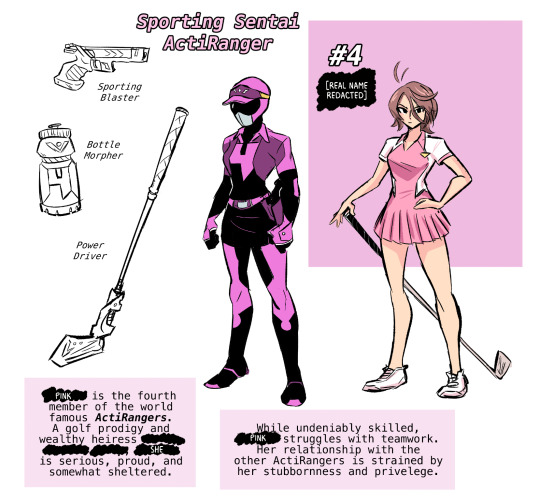
(Real name and certain background elements redacted for spoiler reasons)
So Pink's suit was the first one designed, hence how she's kinda the most basic of the Rangers. I had just got done watching Birdie Wing and Love After World Domination and thought it would be kinda fun for a golf themed sentai hero.
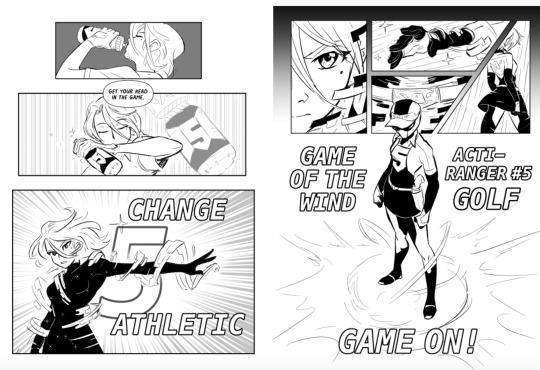
She was originally going to be ActiRanger 5 before I thought of the "Four/Fore" golf pun.
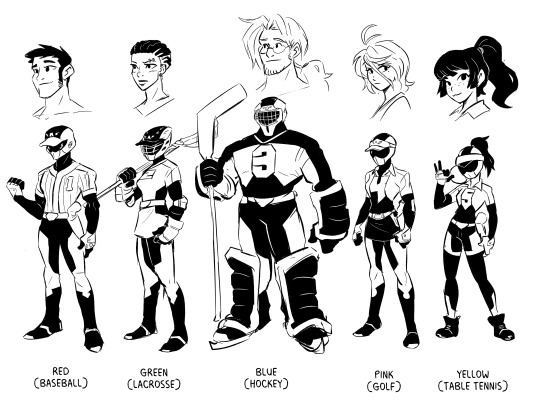
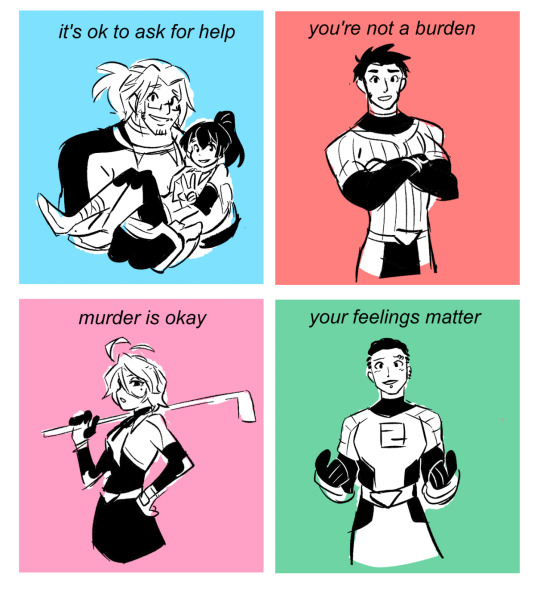
The rest of the team was then designed from there with each of their sports in mind and some general vibes.
I don't think they went through all that much iteration, though I will say since I tend to draw them in Black and White I sometimes mix up which parts of their suits are their color and which parts are black.
I wanted to give them each some kind of Power Weapon so I stuck to stick sports and also Table Tennis. (I am still weirdly fond of the old Penny Arcade Paint the Line comics)
As far as Power Ranger teams that inspired them, Mighty Morphin' is obviously the biggest inspo. (The Dan Mora run on the Go Go Power Rangers comics is awesome.) Time Force, S.P.D. and RPM were all on my mind as well.
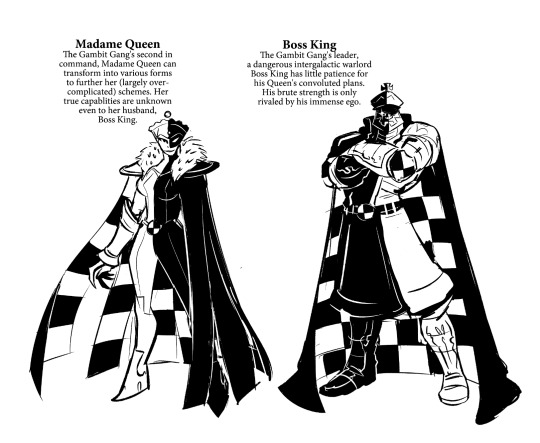

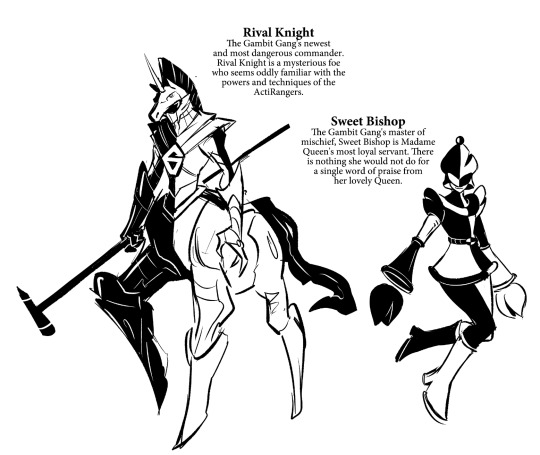
For the Gambit Gang I was struggling to come up with a fun villain theme and eventually figureod out that the enemy to the "Sports" team had to be the "Chess Club". (Insert joke about polycules and board games)
Gray in particular was conceived at this point when I and wanted an Evil Ranger on their side. Chess Knights having a vague horse theme, he obviously had to be Polo! His design draws pretty heavily from Mystic Force's Koragg which is still IMO one of the sickest designs Sentai has ever cooked.
Wow that got a little more long winded than I inteded but I hope y'all enjoyed this little peek behind the curtain of the ActiRanger's development!
Thank you all for enjoying my silly OC comics and doodles!
2K notes
·
View notes
Text
I have gotten a lot of messages saying that they really love the presentation of CURSE/KISS/CUTE. Often the commenter in question can’t say what exactly it is about the formatting that they appreciate, but that it just reads well and looks good. Well!!! Allow me to bare my wealth of secret knowledge for you once and for all:
I sorta just did some research into book typography...?
Here’s something you should know about web development, alright: typography on the web is really, really bad. The tools we have at our disposal—HTML and CSS—are incredibly powerful, but they are set up to fight you every step of the way towards Good Typography. When you know what you’re looking for, you can fix all the common issues quickly and easily. But it’s not easy to know what to look for, because
problematic typography is overwhelmingly the norm on the web, and
good typography is invisible.
Here’s a screenshot from CURSE/KISS/CUTE episode 0:

Now, I don’t want this post to come across as prescriptive. It is not my intention to tell you, “This is what good typography looks like, so follow my lead exactly.” I made a lot of choices with the typography of my web novel: many of those choices would not make sense in other contexts. What I want to convey to you is what those choices are, so that you will know they’re available to be made.
I mentioned that the web “fights you” when it comes to good typography. What do I mean by that? Well, check this out:

This is how that passage of text renders “by default.” In other words, this is how a web browser would render that text without any input from me about what styles to apply. It kind of sucks ass! But it also looks pretty familiar, right? This is not that far off from how a lot of websites—even websites full of prose (looking at you, AO3)—render text.
I think the most illustrative thing to do here would be to walk you through my thought process and show you, step by step, what decisions I made to turn this unstyled text into the styled version you see in the novel.
So, first things first:
1. We have got to shrink that text column.
Computer monitors... are wide. They are wider than they are tall. They are so wide, and they have so many pixels. This means you can fit a lot of characters on them. If you wanted, you could just have a wall of characters from the left side of the screen all the way to the right side. Talk about efficient!!
You should never, ever, ever do this.
This is one choice that I actually will make a prescriptive statement about, because it’s supported by quite a lot of research: fairly narrow text columns are more legible. Specifically, research seems to support the idea that a width in the range of 50 to 70 characters per line is the most comfortable for people to read*. Every font is different, so it takes a little doing to turn that “characters” figure into a pixel measurement; I went with 512 CSS pixels for the maximum width of my text column:

Isn’t that just so much nicer to read already?
*A commenter reminds me that I’d be remiss not to point out that the research on column width legibility isn’t completely conclusive. You do want to limit the width of your text columns, but going over the 70 character-per-line recommendation isn’t necessarily the end of the world, and you might have good reasons to do so. I did not: as mentioned, one of my goals was to mimic book-style typography, and books by nature have fairly restrained column widths, on account of they’re books.
2. Picking a font.
I’m not going to give you the blow-by-blow on how I decided what font to use. The short story is that I asked some designers, and one of the recommendations I got was the free font Crimson Pro, which I took a liking to immediately:

It’s just an all-around attractive serif font, but one thing I really like about it for use in a novel is its highly-visible quotation marks. They’re just kinda jumbo! They’re real big! Easy to see! In a novel, those things aren’t just ornamentation. It makes a great deal of practical sense for them to stand out just a bit. It also has a fairly large x-height, unlike a lot of the more traditional options, which is good for legibility on a computer screen.
3. Adjusting the line-height
Web browsers default to a line-height of about 1.2em, which, as you can probably tell, is quite cramped. If you go and Google “optimal line height for legibility”, you’ll get a number of results right off the bat suggesting 1.5em. Sounds good! Let’s do that:

Well... hmm. That’s definitely an improvement, but between you and me, it actually looks a bit too spacey to my eyes. I wonder why?
I’ll cut to the chase: the 1.5em recommendation makes some assumptions about the font you’re using. In Arial, the letter “A” is about 0.6em tall; in Crimson Pro, it’s about 0.5em. That means that there’s no one-size-fits-all solution to spacing your lines, because different fonts have different amounts of empty space baked in. How annoying!
Let me tell you something about the kind of nerd I am. When I had this realization, I grabbed some books off my shelf and pulled out a literal micrometer. I started measuring the line-heights against various font features to see if there were any patterns I could spot in professional typesetting. Here’s what I found:

Almost every book on my shelf spaces lines such that the distance between one baseline and the next is about three times the x-height. How cool is that? I clapped my hands like a seal when I put this together.
Adjusting the line-height to match what I observed in the wild gives us this:

It’s a subtle difference, but to my eyes it feels just right. It’s almost like magic!
4. Paragraph spacing...
Let’s address the elephant in the room. Probably the most controversial choice I made with CURSE/KISS/CUTE’s typography was to opt for book-style paragraph indentation rather than web-style paragraph spacing—like so:

I did this for a few reasons:
It’s what I’m used to. I’ve read a lot of books, and this is just the way that books are formatted. I think for something aspiring to the title of “novel”, there’s value in making it look the way a reader probably expects a novel to look.
A novel has a lot of paragraph breaks in it. A paragraph in, say, an encyclopedia entry might go on for half a page or more; whereas it is unusual for a paragraph in a modern work of narrative prose to run for more than a handful of sentences, especially in any scene with dialogue. Because paragraph breaks are so common, spacing between paragraphs in a novel results in a lot of wasted space. Also, subjectively speaking, the additional space seems to me to lend an undue amount of weight to paragraph breaks. I’m just starting a new thought; there’s no need for a 21-gun salute, you know?
Having said that, here are some good reasons you might decide not to do paragraph indentation anyway:
Doing it right requires a bit of extra legwork. Notice how the very first paragraph in the image above has no indentation. That’s because it’s the start of a new section, and the first paragraph in a section traditionally goes unindented. This is an easy detail to miss, and it can be difficult to wrangle CSS into doing it for you automatically.
Web users don’t expect it. For the first decade of the web’s existence, there was no good way to do paragraph indentation; by the time CSS rolled around and made it easy, paragraph spacing had already become the norm. And while CURSE/KISS/CUTE may be a novel, it is also, specifically, a web novel!
But it’s my house and I get to make the rules, so I went with indentation. Incidentally, there seems to be a dire lack of research into the question of whether indentation or spacing is more legible for readers—but the data that does exist appears inconclusive at best. So, the choice really does come down to vibes.
5. The tragedy of justification.
You’ll note that one way in which I did not make my web novel look like a paper novel is the text alignment. It’s un-justified: the right margin is ripsaw-ragged.
This is because it is not possible to justify text on the web.
Oh, you can try. Look right here: there’s a CSS property for it and everything. Just turn on “text-align: justify” and...

Nightmare! The interword spacing on that first line is almost as wide as the indentation!
Reader, I’m afraid that your web browser is simply too dumb. That’s not the browser’s fault: robust algorithms for justifying text without creating these distractingly huge gaps between words have existed for many decades, and modern computers are powerful enough to run them in real time with little performance impact. It’s just, uh—nobody has ever bothered to implement them into web browsers. It is the damnedest thing.
I tried, I really did. You can mitigate this problem a bit if you enable automatic hyphenation, but browsers are unfortunately also kind of dumb at hyphenating. Firefox, for example, will refuse to hyphenate any word containing a capital letter, so any sentence with a lot of proper nouns in it is a lost cause. I tried manually inserting soft hyphens with a text preprocessor I wrote myself, but still these overjustified lines plagued me: when the text column narrows, for example on a phone, even hyphens can’t save you. The line-breaking algorithm is simply too naïve to optimize for well-justified text, and that’s not something you can fix as a web developer.
As a result, my heavy-hearted recommendation is to never use text justification. It’s just too distracting.
6. And then some extra stuff just for me

I added drop-caps because it looks neat and I made the ellipses spacier because I think it looks good when it, uh, when they are spacier. I think that looks pretty good that’s just my opinion though.
That’s all! Hope you learned something bye!!!
493 notes
·
View notes
Text
A bit of a hot take??? I really hope future Sonic games start looking at Sonic Boom for character animation references. And no, I don't mean the show.
I think we're at a point when we can look past all the bugs and glitches this game had at release (if you'd had the opportunity to play it recently you'd see that, while there's still bugs, they barely affect the gameplay anymore, which is a HUGE step from when it was first released), and look at the art in it. While there's a lot I love about Sonic Boom aesthetically, I want to focus on the characters animation, especially in cutscenes.
I'm not exaggerating when I say I think this game has better facial animation than any other Sonic game, and while Sonic Frontiers was a step in the right direction, I don't think it compares to Sonic Boom and I do mean that in all honesty.
Here I put together just a FEW examples of how expressive the characters are in this game:
LOOK AT HOW EXPRESSIVE THEY ALL ARE! HOW NATURALLY THEIR BODIES MOVE WITH THEIR ACTIONS! HOW THEY INTERACT WITH EACH OTHER WITHOUT SAYING ANYTHING AT ALL! HOW WE CAN SEE THEIR THOUGHT PROCESS HAPPENING IN THEIR HEAD!! THIS IS WHAT I WANT TO SEE IN FUTURE SONIC GAMES!!!
This is truly the best I've seen of these characters in games!!! And I really hope we can move in this direction from here!! I just love how much personality they have in this game, not only in their dialogue, but also represented by their body language. Like I said, Sonic Frontiers was a good step towards this, but I would really like if we stopped focusing on just the bugs this game has, and paid attention to some of the great decisions the developers made! There's so much to be rescued from this almost completely ignored game, and I would love to go back to this style of animation in the future.
Also I love the vibes of this universe and the character designs because they all look so different from each other and there's more diversity in the body types and all but that's not the point of this post NSKZNSNXNSMX
1K notes
·
View notes
Text
Everyone’s obsession with trying to justify Stella’s behavior is sooo icky to me.
“Well why they write her like that just as a prop to make Stolas look better.”
Has it ever occurred to you through the process of making a story certain characters exist to be a foil to the main protagonists. That not all characters are meant to be sympathetic or to be sympathized with and that’s not a fault in writing.
Someone being a villain character isn’t bad writing, and not having a character entire story before a show is over and claiming how under developed a character is- well a little idiotic.
Events have to happen in a certain order in a story for it to make sense, I’m sure we’ll find out more about Stella as the show goes on.
And there is also the huge can of worms of people trying to justify Stella’s actions. Male victims of abuse are hardly ever shown. Why are you trying to make Stella seem like the good person in this?
Yes it was an arranged marriage, yes it’s fair to say Stella was unhappy about that. That does not justify Stella abusing Stolas. Guess what Stolas was never happy about the arranged marriage either. Not to mention he is literally a gay man, but he didn’t become abusive.
“Oh but he cheated on her.”
Yeah after almost two decades of being abused and in a loveless hollow marriage. That’s hardly the same as being abused. Also that’s pretty common to happen to people being abused it’s behavior of someone trying to get out of a bad situation.
Y’all keep saying there is no depth and then try and take it out the messy nature of these things.
Legitimately if Stolas was a woman and Stella a man you’d all be praising Stolas. Support male domestic abuse victims and stop justifying abusive woman.
And of course that’s not saying you can’t like Stella as a character, just stop trying to make her seem like the victim. Stop saying you love her as a character and then going “well why did they write them like this, why didn’t they write them as having a friendly relationship.” Because that’s not the story being told.
And while I’m at it I know some people hate Octavia but she’s honestly great from what we’ve seen of her. “Why does he hate her more than he loves me?” As someone who grew up around this situation in my older teen I felt that. I felt that hard, these things are complicated for all people involved.
#helluva boss#helluvaverse#stella#stolas#seriously stop treating her like she doesn’t know what she’s doing
283 notes
·
View notes
Text
Sebastian Stan Tells All: Becoming Donald Trump, Gaining 15 Pounds and Starring in 2024’s Most Controversial Movie
By Daniel D'Addario
Sebastian Stan Variety Cover Story

It started with the most famous voice on the planet, the one that just won’t shut up.
Sebastian Stan, in real life, sounds very little like Donald Trump, whom he’s playing in the new film “The Apprentice.” Sure, they share a tristate accent — Stan has lived in the city for years and attended Rutgers University before launching his career — but he speaks with none of Trump’s emphasis on his own greatness. Trump dwells, Stan skitters. Trump attempts to draw topics together over lengthy stem-winders (what he recently called “the weave”), while Stan has a certain unwillingness to be pinned down, a desire to keep moving. It takes some coaxing to bring Stan, a man with the upright bearing and square jaw of a matinee idol, to speak about his own process — how hard he worked to conjure a sense Trump, and how he sought to bring out new insights about America’s most scrutinized politician.
“I think he’s a lot smarter than people want to say about him,” Stan says, “because he repeats things consistently, and he’s given you a brand.” Stan would know: He watched videos of Trump on a loop while preparing for “The Apprentice.” In the film, out on Oct. 11, Stan plays Trump as he moves from insecure, aspiring real estate developer to still insecure but established member of the New York celebrity firmament.
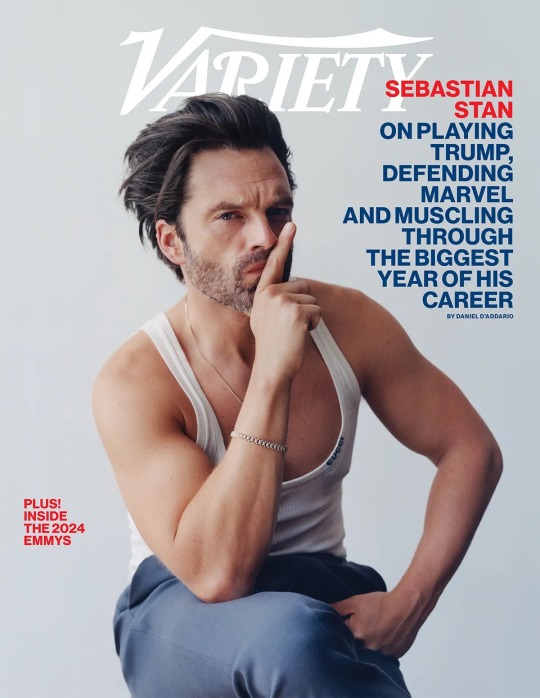
We’re sitting over coffee in Manhattan. Stan is dressed down in a black chore coat and black tee, yet he’s anything but a casual conversation partner. He rarely breaks eye contact, doing so only on the occasions when he has something he wants to show me on his iPhone (cracked screen, no case). In this instance, it’s folders of photos and videos labeled “DT” and “DT PHYSICALITY.”
“I had 130 videos on his physicality on my phone,” Stan says. “And 562 videos that I had pulled with pictures from different time periods — from the ’70s all the way to today — so I could pull out his speech patterns and try to improvise like him.” Stan, deep in character, would ad-lib entire scenes at director Ali Abbasi’s urging, drawing on the details he’d learned from watching Trump and reading interviews to understand precisely how to react in each moment.
“Ali could come in on the second take and say, ‘Why don’t you talk a little bit about the taxes and how you don’t want to pay?’ So I had to know what charities they were going to in 1983. Every night I would go home and try not only to prepare for the day that was coming, but also to prepare for where Ali was going to take this.”
Looking at Stan’s phone, among the endless pictures of Trump, I glimpse thumbnails of Stan’s own face perched in a Trumpian pout and videos of the actor’s preparation just aching to be clicked — or to be stored in the Trump Presidential Library when this is all over in a few months, or in 2029, or beyond.
“I started to realize that I needed to start speaking with my lips in a different way,” Stan says. “A lot of that came from the consonants. If I’m talking, I’m moving forward.” On film, Stan shapes his mouth like he can’t wait to get the plosives out, puckering without quite tipping into parody. “The consonants naturally forced your lips forward.”
“If he did 10% more of what he did, it would become ‘Saturday Night Live,’” Abbasi says. “If he did 10% less, then he’s not conjuring that person. But here’s the thing about Sebastian: He’s very inspired by reality, by research. And that’s also the way I work; if you want to go to strange places, you need to get your baseline reality covered very well.”
A little later, Stan passes me the phone again to show me a selfie of him posing shirtless and revealing two sagging pecs and a bit of a gut. He’s pouting into a mirror. If his expression looks exaggerated, consider that he was in Marvel-movie shape before stepping into the role of the former president; the body transformation happened rapidly and jarringly. Trump’s size is a part of the film’s plot — as Trump’s sense of self inflates, so does he. In a rush to meet the shooting deadline for “The Apprentice,” Abbasi asked Stan, “How much weight can you gain?”
“You’d be surprised,” Stan tells me. “You can gain a lot of weight in two months.” (Fifteen pounds, to be exact.)
Now he’s back in fighting form, but the character has stayed with him. After years of playing second-fiddle agents of chaos — goofball husbands to Margot Robbie’s and Lily James’ characters in “I, Tonya” and Hulu’s “Pam & Tommy,” surly frenemy to Chris Evans’ Captain America in the Marvel franchise — Stan plunged into the id of the man whose appetites have reshaped our world. He had to have a polished enough sense of Trump that he could improvise in character, and enough respect for him to play him as a human being, not a monster.

It’s one of two transformations this year for Stan — and one that might give a talented actor that most elusive thing: a brand of his own. He’s long been adjacent enough to star power that he could feel its glow, but he hasn’t been the marquee performer. While his co-stars have found themselves defined by the projects he’s been in — from “Captain America” and “I, Tonya” back to his start on “Gossip Girl” — he’s spent more than a decade in the public eye while evading being defined at all.
This fall promises to be the season that changes all that: Stan is pulling double duty with “The Apprentice” and “A Different Man” (in theaters Sept. 20), in which he plays a man afflicted with a disfiguring tumor disorder who — even when presented with a fantastical treatment that makes him look like, well, Sebastian Stan — can’t be cured of ailments of the soul. For “A Different Man,” Stan won the top acting prize at the Berlin Film Festival; for “The Apprentice,” the sky’s the limit, if it can manage to get seen. (More on that later.)
One reason Stan has largely evaded being defined is that he’s never the same twice, often willing to get loopy or go dark in pursuit of his characters’ truths. That’s all the more true this year: In “The Apprentice,” he’s under the carapace of Trumpiness; in “A Different Man,” his face is hidden behind extensive prosthetics.
“In my book, if you’re the good-looking, sensitive guy 20 movies in a row, that’s not a star for me,” says Abbasi, who compares Stan to Marlon Brando — an actor eager to play against his looks. “You’re just one of the many in the factory of the Ken dolls.”
This fall represents Stan’s chance to break out of the toy store once and for all. His Winter Soldier brought a jolt of evil into Captain America’s world, and his Jeff Gillooly was the devil sitting on Tonya Harding’s shoulder. Now Stan is at the center of the frame, playing one of the most divisive characters imaginable. So he’s showing us where he can go. The spotlight is his, and so is the risk that comes with it.
Why take such a risk?
The script for “The Apprentice,” which Stan first received in 2019, but which took years to come together, made him consider the American dream, the one that Trump achieved and is redefining.
Stan emigrated with his mother, a pianist, from communist Romania as a child. “I was raised always aware of the American dream: America being the land of opportunity, where dreams come true, where you can make something of yourself.” He pushes the wings of his hair back to frame his face, a gold signet ring glinting in the late-summer sunlight, and, briefly, I can hear a hint of Trump’s directness of approach. “You can become whoever you want, if you just have a good idea.” Stan’s good idea has been to play the lead in movies while dodging the formulaic identity of a leading man, and this year will prove just how far he can take it.
“The Apprentice” seemed like it would never come together before suddenly it did. This time last year, Stan was sure it was dead in the water, and he was OK with that. “If this movie is not happening, it’s because it’s not meant to happen,” he recalls thinking. “It will not be because I’m too scared and walk away.”
Called in on short notice and filming from November 2023 to January of this year (ahead of a May premiere in Cannes), Stan lent heft and attitude to a character arc that takes Trump from local real estate developer in the 1970s to national celebrity in the 1980s. He learns the rough-and-tumble game of power from the ruthless and hedonistic political fixer Roy Cohn (Jeremy Strong), eventually cutting the closeted Cohn loose as he dies of AIDS and alienating his wife Ivana (Maria Bakalova) in the process. (In a shocking scene, Donald sexually assaults Ivana in their Trump Tower apartment.) For all its edginess, the film is about Trump’s personality — and the way it calcified into a persona — rather than his present-day politics. (Despite its title, it’s set well before the 2004 launch of the reality show that finally made Trump the superstar he longed to be.)

And despite the fact that Trump has kept America rapt since he announced his run for president in 2015, Hollywood has been terrified of “The Apprentice.” The film didn’t sell for months after Cannes, an unusual result for a major English-language competition film, partly because Trump’s legal team sent a cease-and-desist letter attempting to block the film’s release in the U.S. while the fest was still ongoing. When it finally sold, it was to Briarcliff Entertainment, a distributor so small that the production has launched a Kickstarter campaign to raise money so that it will be able to stay in theaters.
Yes, Hollywood may vote blue, but it’s not the same town that released “Fahrenheit 9/11” or even “W.,” let alone a film that depicts the once (and possibly future) president raping his wife. (The filmmakers stand behind that story. “The script is 100% backed by my own interviews and historical research,” says Gabriel Sherman, the screenwriter and a journalist who covers Trump and the American conservative movement. “And it’s important to note that it is not a documentary. It’s a work of fiction that’s inspired by history.”) Entertainment corporations from Netflix to Disney would be severely inconvenienced if the next president came into office with a grudge against them.
“I am quite shocked, to be honest,” Abbasi says. “This is not a political piece. It’s not a hit piece; it’s not a hatchet job; it’s not propaganda. The fact that it’s been so challenging is shocking.” Abbasi, born in Iran, was condemned by his government over his last film, “Holy Spider,” and cannot safely return. He sees a parallel in the response to “The Apprentice.” “OK, that’s Iran — that is unfortunately expected. But I wasn’t expecting this.”
“Everything with this film has been one day at a time,” Stan says. The actor chalks up the film’s divisiveness to a siloed online environment. “There are a lot of people who love reading the [film’s] Wikipedia page and throwing out their opinions,” he says, an edge entering his voice. “But they don’t actually know what they’re talking about. That’s a popular sport now online, apparently.”
Unprompted, Stan brings up the idea that Trump is so widely known that some might think a biographical film about him serves no purpose. “When someone says, ‘Why do we need this movie? We know all this,’ I’ll say, ‘Maybe you do, but you haven’t experienced it. The experience of those two hours is visceral. It’s something you can hopefully feel — if you still have feelings.’”
After graduating from Rutgers in 2005, Stan found his first substantial role on “Gossip Girl,” playing troubled rich kid Carter Baizen. Like teen soaps since time immemorial, “Gossip Girl” was a star-making machine. “It was the first time I was in serious love with somebody,” he says. (He dated the series’ star, Leighton Meester, from 2008 to 2010.) He feels nostalgic for that moment: “Walking around the city, seeing these same buildings and streets — life seemed simpler.”
Stan followed his “Gossip Girl” gig with roles on the 2009 NBC drama “Kings,” playing a devious gay prince in an alternate-reality modern world governed by a monarchy, and the 2012 USA miniseries “Political Animals,” playing a black-sheep prince (and once again a gay man) of a different sort — the son of a philandering former president and an ambitious former first lady.
When I ask him what lane he envisioned himself in as a young actor, he shrugs off the question. “I grew up with a single mom, and I didn’t have a lot of male role models. I was always trying to figure out what I wanted to be. And at some point, I was like, I could just be a bunch of things.”

Which might seem challenging when one is booked to play the same character, Bucky Barnes, in Marvel movie after Marvel movie. Bucky’s adventures have been wide-ranging — he’s been brainwashed and turned evil and then brought back to the home team again, all since his debut in 2011’s “Captain America: The First Avenger.” Next year, he’ll anchor the summer movie “Thunderbolts,” as the leader of a squad of quirky heroes played by, among others, Julia Louis-Dreyfus and Florence Pugh. It’s easy to wonder if this has come to feel like a cage of sorts.
Not so, says Stan. His new Marvel film “was kind of like ‘One Flew Over the Cuckoo’s Nest’ — a guy coming into this group that was chaotic and degenerate, and somehow finding a way to unite them.”
Lately, knives have been out for Marvel movies as some have disappointed at the box office, and “Thunderbolts,” which endured strike delays and last-minute cast changes, has been under scrutiny.
“It’s become really convenient to pick on [Marvel films],” Stan says. “And that’s fine. Everyone’s got an opinion. But they’re a big part of what contributes to this business and allows us to have smaller movies as well. This is an artery traveling through the system of this entire machinery that’s Hollywood. It feeds in so many more ways than people acknowledge.” He adds, “Sometimes I get protective of it because the intention is really fucking good. It’s just fucking hard to make a good movie over and over again.”
Which may account for an eagerness to try something new. “In the last couple of years,” he says, “I’ve gotten much more aggressive about pursuing things that I want, and I’m constantly looking for different ways of challenging myself.”
The challenge continued throughout the shoot of “The Apprentice,” as Stan pushed the material. “One of the most creatively rewarding parts of the process was how open Sebastian was to giving notes on the script but also wanting to go beyond the script,” says Sherman, the screenwriter. “If he was interested in a certain aspect of a scene, he was like, Can you find me a quote?” he recalls.
Building a dynamic through improvised scenes, Stan and Strong stayed in character throughout the “Apprentice” shoot. “I was doing an Ibsen play on Broadway,” says Strong, who won a Tony in June for his performance in “An Enemy of the People,” “and he came backstage afterwards. And it was like — I’d never really met Sebastian, and I don’t think he’d ever met me. So it was nice to meet him.”
Before the pair began acting together, they didn’t rehearse much — “I’m not a fan of rehearsals,” Strong says. “I think actors are best left in their cocoon, doing their work, and then trusted to walk on set and be ready.” The two didn’t touch the script together until cameras went up — though they spent a preproduction day, Strong says, playing games in character as Donald and Roy.
After filming, both have kept memories of the hold their characters had on them. They shared a flight back from Telluride — a famously bumpy trip out of the mountains. “He’s a nervous flyer, and I’m a nervous flyer,” Stan says. Both marveled at the fact that they’d contained their nerves on the first day of shooting “The Apprentice,” when their characters traveled together via helicopter. “We both go, ‘Yeah — but there was a camera.’”
Stan’s aggressive approach to research came in handy on “A Different Man,” which shot before “The Apprentice.” His character’s disorder, neurofibromatosis, is caused by a genetic mutation and presents as benign tumors growing in the nervous system. After being healed, he feels a growing envy for a fellow sufferer who seems unbothered by his disability.
Stan’s co-star, Adam Pearson, was diagnosed with neurofibromatosis in early childhood. Stan found the experience challenging to render faithfully. “I said many times, I can do all the research in the world, but am I ever going to come close to this?” Stan says. “How am I going to ever do this justice?”
Plus, he had precious little time to prepare: “He was fully on board, and the film was being made weeks later,” director Aaron Schimberg says. “Zero to 60 in a matter of weeks.”
The actor grappled for something to hold on to, and Pearson sug gested he refer to his own experience of fame. “Adam said to me, ‘You know what it’s like to be public property,’” Stan says.
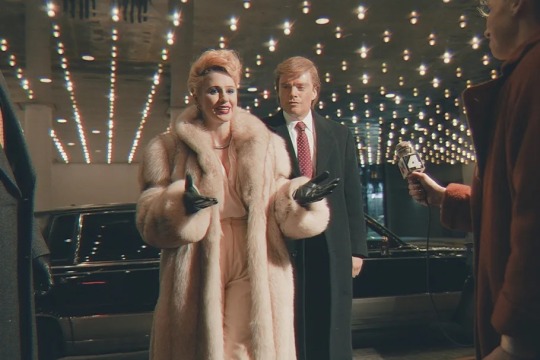
Pearson recalls describing the experience to Stan this way: “While you don’t understand the invasiveness and the staring and the pointing that I’ve grown up with, you do know what it’s like to have the world think you owe them something.”
That sense of alienation becomes universal through the film’s storytelling: “A Different Man” takes its premise as the jumping-off point for a deep and often mordant investigation of who we all are underneath the skin.
The film was shot in 22 days in a New York City heat wave, and there was, Schimberg says, “no room for error. I would get four or five takes, however many I could squeeze out, but there’s no coverage.”
Through it all, Stan’s performance is utterly poised — Schimberg and Stan discussed Buster Keaton as a reference for his ability to be “completely stone-faced” amid chaos, the director says. And the days were particularly long because Oscar-nominated prosthetics artist Michael Marino was only able to apply Stan’s makeup in the early morning, before going to his job on the set of “The Marvelous Mrs. Maisel.”
“Even though I wasn’t shooting until 11 a.m., I would go at like 5 in the morning to his studio, or his apartment,” Stan recalls. The hidden advantage was that Stan had hours to kill while made up like his character, the kind of person the world looks past. “I wanted to walk around the city and see what happened,” Stan says. “On Broadway, one of the busiest streets in New York, no one’s looking at me. It’s as if I’m not even there.” The other reaction was worse: “Somebody would immediately stop and very blatantly hit their friend, point, take a picture.”
It was a study in empathy that flowed into the character. Stan had spoken to Pearson’s mother, who watched her son develop neurofibromatosis before growing into a disability advocate and, eventually, an actor. “She said to me, ‘All I ever wanted was for someone to walk in his shoes for a day,’” Stan recalls. “And I guess that was the closest I had ever come.”
“The Apprentice” forced Stan, and forces the viewer, to do the same with a figure that some 50% of the electorate would sooner forget entirely. And that lends the film its controversy. Those on the right, presupposing that the movie is an anti-Trump document, have railed against it. In a statement provided to Variety, a Trump campaign spokesman said, “This ‘film’ is pure malicious defamation, should never see the light of day and doesn’t even deserve a place in the straight-to-DVD section of a bargain bin at a soon-to-be-closed discount movie store, it belongs in a dumpster fire.” The campaign threatened a lawsuit, though none has materialized.
Asked about the assault scene, Stan notes that Ivana had made the claim in a deposition, but later walked it back. “Is it closer to the truth, what she had said directly in the deposition or something that she retracted?” he asks. “They went with the first part.”
The movie depicts, too, Ivana’s carrying on with her marriage after the violation, which may be still more devastating. “How do you overcome something like this?” asks Bakalova. “Do you have to put on a mask that everything is fine? In the next scene, she’s going to play the game and pretend that we’re the glamorous, perfect couple.” The Trumps, in “The Apprentice,” live in a world of paper-thin images, one that grows so encompassing that Donald no longer feels anything for the people to whom he was once loyal. They’re props in his stage show.
“The Apprentice” will drop in the midst of the most chaotic presidential election of our lifetime. “The way it lands in this extremely polarized situation, for me as an artist, is exciting. I won’t lie to you,” says Abbasi.
When asked if he was concerned about blowback from a Trump 47 presidency, Stan says, “You can’t do this movie and not be thinking about all those things, but I really have no idea. I’m still in shock from going from an assassination attempt to the next weekend having a president step down [from a reelection bid].”
Stan’s job, as he sees it, was to synthesize everything he’d absorbed — all those videos on his phone — into a person who made sense. This Trump had to be part of a coherent story, not just the flurry of news updates to which we’ve become accustomed.
“You can take a Bach or a Beethoven, and everyone’s going to play that differently on the piano, right?” Stan says. (His pianist mother named him for Johann Sebastian Bach.) “So this is my take on what I’ve learned. I have to strip myself of expectations of being applauded for this, if people are going to like it or people are going to hate it. People are going to say whatever they want. Hopefully they should think at least before they say it.”
It’s a reality that Stan is now used to — the work is the work, and the way people interpret him is none of his business. Perhaps that’s why he has run away from ever being the same thing twice. “I could sit with you today and tell you passionately what my truth is, but it doesn’t matter,” he says. “Because people are more interested in a version of you that they want to see, rather than who you are.”
“The Apprentice” has been the subject of extreme difference of opinion by many who have yet to see it. It’s been read — and will continue to be after its release — as anti-Trump agitprop. The truth is chewier and more complicated, and, perhaps, unsuited for these times.
“Are we going to live in a world where anyone knows what the truth is anymore? Or is it just a world that everyone wants to create for themselves?” Stan asks.
His voice — the one that shares a slight accent with Trump but that is, finally, Stan’s own — is calm and clear. “People create their own truth right now,” he says. “That’s the only thing that I’ve made peace with; I don’t need to twist your arm if that’s what you want to believe. But the way to deal with something is to actually confront it.”
#Variety#Sebastian Stan#Photoshoot#A Different Man#The Apprentice#Thunderbolts*#Marvel#Interview#mrs-stans
269 notes
·
View notes
Text
Ask Compilation: Blondes, feet, bowl-cut guardian lady.

He did not, they never had sex. But he was in love with her.

For sure. I think she struck him more like a teenager with the black hair and bangs, after the change (both visual and in attitude) she became a far more mature AND attractive person in his eyes.
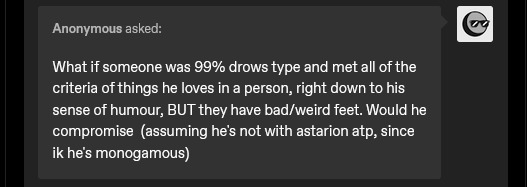
PFFT, well, if you're saying they meet ALL of the criteria, I assume you mean both in looks and personality and hence be damn near his soulmate. DU drow could overlook weird feet (and a lot of other things, actually) if he were in love with the person in question. He would probably gently request they take better care of them, though.

Nothing special there, I'm afraid! He just has human-like skin - perhaps a little on the oily side but completely within the bounds of normality.
He runs a little hot, if that's anything. Oh! His hair is shockingly soft.
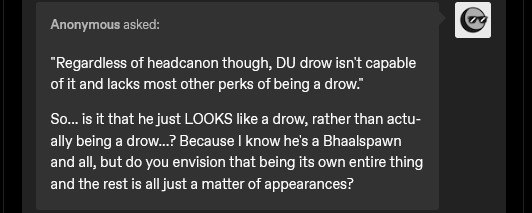
Correct! DU drow only (arguably) looks like a drow. He doesn't have their usual bone structure, height, or associated magical proclivities. He has some dark vision but its nowhere near as good as a drow's either.
I don't necessarily think all Bhaalspawn are the same way, but the Dark Urge IS quite different from the previous game's iterations. DU isn't simply Bhaal's child conceived with a partner, he's a piece of the god that supposedly slobbed off and grew legs and a face, pretty much. So yes, I do think that the Dark Urge at least is it's own unique thing.
The reason why he looks like a drow, is because he was placed in the Underdark upon creation. The metaphor I always use here is that if you place something infantile in a biome that is alien to it, it may try to adapt to it's environment to survive as it develops, to different degrees of success. This is why DU drow looks the way he does.
[MORE UNDER THE CUT]

You're welcome!

I've received a few snippets here that you can find through the #gift art tag! There is also the fic I'm in the process of writing called A Novel Experience on AO3.

It was just something I was compelled to do when I first drew him! The facial scars felt like they should lead into something else so I just made up a pattern on the spot, minus a tiny tweak here or there, it has stuck basically unchanged. All and any lore relating to the scars came later.

I get a lot of sweet messages but "thanks for your man's penis size" has to be one of my favorites. Thank you!

HELLO!
Thank you so much for the kind message! And that sounds like a fun dream, I love that your Tav got jealous of the attention ASTARION was receiving instead of mad that he had to share in the first place LOL
DU drow is desperately monogamous. He doesn't care what other people do with their lives but he's very much a "one and done" kind of person.
He would be willingly to participate in a threeway/have group sex with a partner, assuming the rules and regulations of said encounter were laid out clearly before or at least mutually understood between them. He would never want to see these people again after the fact though.


She does not, naturally I had no idea that this character was going to turn into anything when i made him, so I just... Made a lady. And since she was supposed to be a "guardian" I gave her a Joan of Arc type of look.
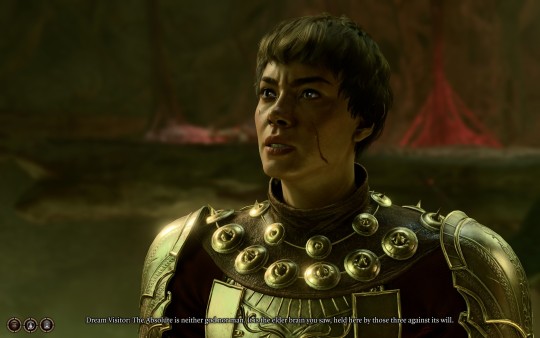
I've occasionally thought about changing this, but... Y'know, sometimes you don't need lore to be that in-depth, LOL.
The emperor gave everyone else a nondescript hottie he assumed they would trust, DU drow just got the same treatment. She's not even DU drow's type but definitely someone he would be compelled to take seriously yet not feel threatened by - so ultimately, her design does make sense.
---
That's all I have the energy for tonight folks, as always thank you for the many encouraging and sweet messages you send me, I'm sorry I can't reply to all of them! 😭
Have yourselves a great week!
164 notes
·
View notes
Text
Progress Checkup! (Aug. 2024) | Scratchin' Melodii Devlog
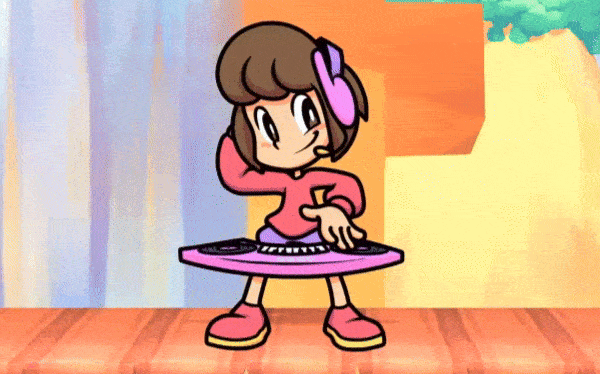
Hello again, strangers! I thought it was about time to add another devlog again! This time I'm trying out a more in-depth approach to this, to somewhat make up for the lack of gameplay previews. Let me know what you think!
For starters, I've revamped the rhythm system 🤯 (like... again! 🤯) Don't freak out, though. Surface level gameplay-wise, it works mostly the same as it did in the last demo, so you won't have to re-learn much. I just needed to redo some things so it'd be easier for me to work with in the long-run while developing the rest of the game. Way less headaches await me now when working on new levels. In the process, I was also able to incorporate some neat new aspects to it and make the core aspects of it better. If you're familiar with older rhythm games, it's now a tad closer to what the dog was doing.
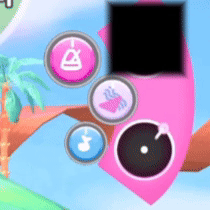
The opponent's icon has been covered up to avoid spoilers. I might be updating all of the character icons soon, actually.
I still plan to revamp the game's tutorial at some point. Something I've noticed is that often, new players don't seem to understand the purpose of the beat dots. Initially, I thought the idea that "on the beat dot = on beat" would come as second nature to new players without need for explanation. However, I hadn't considered that many players are likely to be more familiar with rhythm games that don't even have beat dots in this manner, so they're probably inclined to focus more on getting as close as possible to matching the order of the suggested inputs, and in this game, even at the cost of being off-beat if they aren't keeping up. So, I think the most important thing I need to emphasize when I give a new in-game explanation of the mechanics is the beat dots and really getting new players into the mindset of prioritizing the tempo. I think I should also have the tutorial's gameplay portion try to discretely get the player used to the control scheme to help people who haven't particularly memorized where all of their controller's buttons are without looking. This'll probably result in the tutorial song shown in the demo being replaced in the full game. I do still like its instrumental though, so maybe that will be repurposed for another game feature, at least.
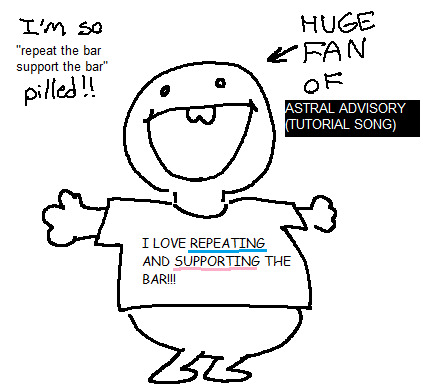
There's probably some guy out there who just REALLY loves Astral Advisory as the tutorial song that will be very upset to hear this. In solidarity with them, I've depicted their enthusiasm with this rather silly image I've created.
As for other levels, now that I've got the updated rhythm system up and running, the 3rd rival battle of act 2 is almost complete. If you didn't like the Pow-Notes in Supastar Tennis, you might not like me very much after this! So far, I think this level has some of the best and most ambitious animation work I've done yet, so I hope you'll look forward to it. Not sure when I'll show a gameplay preview of this level, but I probably will at some point.
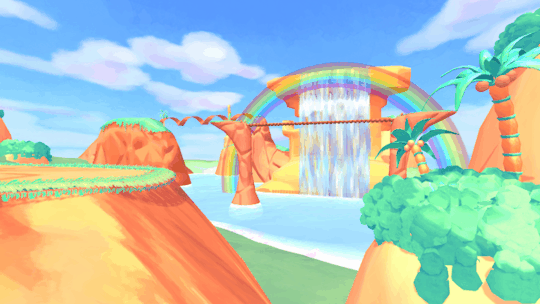
Also, I've made a new logo for the game! I'll gradually be phasing this one in to replace the old one, but until the full game releases you'll probably still see the old one hanging around too in some places.
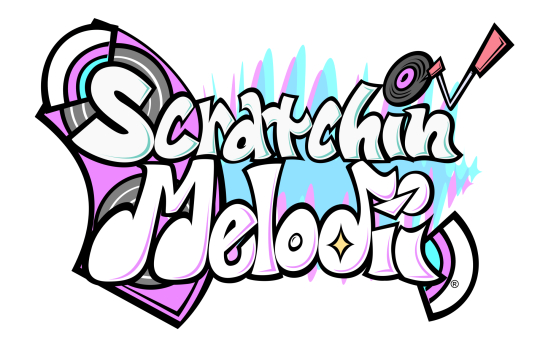
That's all I can talk about for now, but thanks for reading! - LJ
185 notes
·
View notes
Text
Snippets. 🐺💜
For Game Informer’s July 17th DA:TV article, "BioWare On Returning To The Dragon Age Series, 10 Years After Inquisition", the article is still titled as such on its own page, but it looks like on the GI DA:TV Hub page its listing was updated to "Dragon Age: The Veilguard Is 'Respectful And Referential' To Previous Games Without Making Them Mandatory"
[previous comment for context - Brenon: "we do have "decision saves" before big choice moments, but there are still a bunch that depend on a whole mess of stuff you've done earler...so yeah...RIP"]. Derek on this: "Choice and consequence, baby." [source]
[context: DA official Twitter's news about what's coming in August] Derek: "Buckle up!" [source]
Bryony Corrigan (Rook) on the strike: "I care a lot about this game! @/dragonage. Gutted we are unable to speak more about the game for now but absolutely in solidarity with actors in the US. I hope @/EquityUK are also fighting for better protection against AI clauses in the UK too…!" [source]
Matt Rhodes recently wrote to his mailing list that "The project I’ve been working on for many years is nearing completion. In my rare free moments, I’ve been starting to organize concept art to start posting after the game ships." [source] So it sounds like DA:TV is nearing completion and that he will be posting DA:TV concept art that he created after release. [This] is the link to his website where you can view his art, including some existing DA:TV and previous DA game concept art. If you click the envelope symbol on this page, that's how you can subscribe to the mailing list
from Community Councilmember Ladyinsanity - Lucanis x Rook apparently might be an "angst pairing" and there's maybe another one of these in the game also...? 👀 [source]
A user mentioned that they aren't keen on the word "roadmap". Michael Gamble explained: "all it means is a list of cool things you can expect to see us showing." [source]
Bellara's family name Lutare wasn't recently changed as some users wondered, it was Lutare at least a year ago during development. It seems it was just mis-printed or mis-reported in the GI coverage [source]
This article describes DA:TV as the most beautiful game the writer saw at SGF. It says the prologue is dated 9 years after DA:I. "Varric isn’t a ginger so much as a grizzled gray fox now". On Solas, he "wants to tear down the Veil that separates Thedas from the world of demons, restoring his people’s immortality and glory and sacrificing thousands in the process. But when his ritual goes awry, two of his most ancient and powerful adversaries are released. They seek only to finish what they started millennia ago – the complete and utter domination of our world." The game moves quite seamlessly from action to cutscene, and in the prologue "every cutscene is clearly building toward something larger". Position matters in combat. There is an accessibility option which involves the path-tracing of enemies' ranged attacks. At the beginning of the demo, the devs mentioned that they thought about the way different lighting affects your character. " The animations associated with combat are complex for one reason: responsive character features." CC has "inclusion of thick curly hair and capturing the tightly curled texture of Black hairstyles and natural hair", customizable shoulder-width and "a much-welcomed broad spectrum of skin tones—capturing both cool and warm undertones of both white and brown skin". The article highlighted the fluid movement of cloth. The writer also said, "I’m sure other Summer Game Fest previews will have a lot to say on the evolving relationship between Varric and Solas". [source] ((I don't remember seeing this article til now, it's from June though so I either missed it or have seen it and forgotten. also I don't know how accurate it is but the writer was one of the attendees of the DA:TV demo at SGF))
[character limit text break!]
Malcolm: "When I joined DA:Ve I was really hoping there'd be a romanceable dwarf companion and boy howdy did that come true. Harding is ☀️delightful☀️" [source]
[context: this Tumblr post of some neat art] Malcolm: "This is amazing and I fully went "oh wow that really sounds like Emmrich" before remembering that Nick Boraine is in fact a entire human person." [source]
User: "Speaking of Stalker, as a player the description of Bellara and Veil Jumper i've heard so far, alongside their exploration of Arlathan, somehow reminds me of Clear Sky and Chornobyl in Stalker series..." John Epler: "great eye! roadside picnic, Annihilation and STALKER were all absolutely inspirations" [source]
John Epler: "time to slowly make my way home after an awesome 4 days. thanks for an amazing experience to everyone who was a part of it. back to work." [source]
User: "We know there are returning characters in The Veilguard, so my question is: How would you and the rest of the writers go about writing a returning character who was originally primarily written by a writer who is no longer at the studio? What is the process?" Trick Weekes: "1. Watch videos to get the performance, how the character speaks. 2. Don’t try to replicate the character exactly. Allow them to have grown. Morrigan in DAI wasn’t Morrigan in DAO. She’d grown up. 3. Trust Character Art and Performance/VO. As soon as Morrigan walks in and talks in DAI, it works." [source]
Ali Hillis (Harding) on Twitter: "@dragonage @/bioware @/BioWarePulse @/ea #/DragonAge #/SDCC #/SDCC2024 FOLLOW ON INSTA FOR MORE!" [source]
Alex Jordan (Rook): "To all the D&D loving Dragon Age fans out there, let me tell you about my D&D group, made up of faces from the games industry! Including the voices of Geralt from The Witcher, Clive from Final Fantasy XVI, and Noah from Xenoblade! We are @/NaturalSix #/DragonAge" [source]
Erika Ishii (Rook): "Grateful I got to spend SDCC celebrating my roles in 2 games I love. Thank you to the devs (including laid-off workers who deserve full credit!), my friends, and the community. This is the last you’ll hear from me about my games from struck companies until they sign an interim agreement or the strike is won. Keep playing games, but share info from the union and let people know we’re taking a stand for all creatives. See you on the other side! ✊🏼🎮" [source]
Jeff Berg (Rook): "Damn, I love making video games. It’s like the perfect blending of theatre on film, where an actor is encouraged to collaborate and let their imaginations soar. And damn, do I ever love the incredible support from the fans of this incredible medium. Unfortunately, we’re in a time of upheaval in the industry. So let me make it perfectly clear: Video game performers deserve fair wages, safe working conditions and A.I. protections. I call on the employers to #/LevelUpTheContract. Guys, this is no single player game. We need you on our team. #/SagAftraStrong #/VideoGameStrike". Text in the accompanying video reads “Video game performers are stuck in a grind. AI is stealing voices, and companies are hoarding profits. The future of voiceover and performance capture artists is at stake. But out fight isn’t single-player. Whether you’re a gamer, a fan, a performer, a labor ally, or just someone believes in fairness. Keep video games people powered. We need you on our team. Video game companies must offer AI protections to ALL video game performers. Join me and show your support for those who bring our favorite games to life.” [source]
Jessica Clark (Neve): "Aaah a true bucket list moment!! Thrilled to play Neve Gallus a Private Investigator & one of the companions in the upcoming DragonAge The Veilguard Video Game!! We are appearing at the San Diego Comic Con as we speak!! With so much thanks & appreciation for the most fantastic team @/bioware & inspiring fellow cast members including (not limited to) @/missalihillis @/nickboraine @/zach.mendez @/jeffberg1 & more 🙏🏽 Draon Age The Veilguard releases this Fall 2024 & from what I've seen... It's truly epic!! You will love it & yes, it's worth the wait. (SAG-AFTRA issued us a specific window to promote & celebrate at Comic Con & from Sunday night onwards we will all be joining our fellow actors in the picket line for the Video Game Strike)." Text in the accompanying video reads "I’ve wanted to share this for so long! Thrilled to reveal that I play Neve Gallus in the upcoming Dragon Age The Veilguard!! Appearing at Comic Con San Diego as we speak” [source]

[source]
Jessica: "Last night's Comic Con San Diego's Fandom red carpet celebrating Dragon Age The Veilguard! Releasing this Fall 2024!!" [source]
Zach Mendez (Lucanis): "A truly amazing first day of SD Comic Con at the @/dragonagegame poster signing at @/darkhorsecomics booth. Thank you to the fans who made my first con unforgettable #/sdcc /#sdcomiccon #/dragonage #/darkhorsecomics #/lucanisdellamorte #/voiceacting #/bioware #/eagames #/theveilguard #/babysfirstcon" [source]
Zach: "Dragon Age. Dancing. Derulo. Thanks @/fandom for a killer party" [source]
Nick Boraine (Emmrich): "Thank you @/bioware @/ea and @/comic_con - had an incredible time! #/dragonage #/theveilgaurd #/emmrichvolkarin @/zach.mendez @/missalihillis @/thejessicaroseclark - can’t wait for the fall release date." [source]
Ali: "Honored and thrilled to have been a part of another epic @/bioware story w @/ea . Thanks from the bottom of my heart to the whole team! We worked hard, and put our all into this one. Can’t wait to see you all at #/sdcc2024 this week to celebrate @/dragonagegame #/dragonageveilguard" [source]
Ali: "1st day of San Diego Comic Con 2024 !! The lines were long and the signings so much fun! Met some really nice fans, hung out w dragon age performance director @/ashley___barlow , companions @/thejessicaroseclark @/zach.mendez & Nick Boraine . So SO grateful for this #/dragonageveilguard family!" [source]
Ali: "I love every one of these people. There, I said it! What a warm welcome we received! Thanks to ALL! For EVERYTHING!" [source]
Ali on SDCC: "Gooooooood times. ❤️" [source]
Here is a 'behind the scenes at the DA:TV SDCC panel' photo -

[source]
Here is a photo of Erika Ishii with Rook's blue knife -

[source]
Here is an excerpt from Brianne Battye's website:

Text reads: "Dragon Age: The Veilguard Defy the gods. Rise as Rook, Dragon Age’s newest hero. Be who you want to be and play how you want to play as you fight back and lead your team of seven companions, each with their own rich story. Together, you will become the Veilguard. Coming soon From EA/BioWare. I was responsible for a companion story arc, significant side characters, faction content, exploration content, and helping develop and expand worldbuilding lore."
[source]
Also, last year Zach Mendez (Lucanis) made a prior podcast appearance:
Zach: "I was lucky enough over the pandemic to have just hit a really nice commercial, and then I got this beautiful job on a video game where I was doing motion capture. Motion capture? Okay, so you put on this leotard, this black suit, and those little dots on, and you do all the motion for a video game, and you get to do the voice, and they put all these black lines on your face, so they capture your performance and whatnot. And so I was doing that and had some commercial money, so throughout the pandemic, for the past few years, I’ve just been getting to live off acting, which is great." -- Zach: "[Voiceover is] what I'm working on right now." -- Zach: "My father's from Spain." -- Zach: "I'm currently working on a video game, I can't say which video game." "It is a big one, it's not a big deal, it's a big one, I'm one of the main characters, it's not that big a deal." The interviewer asked about how acting in video games works. "Somebody's giving some performance that of course, they layer on imaging afterwards, like in graphics, right? But you're giving facial expressions, that's what gives it the reality, that's what I find so fascinating about motion capture, is that, you get to give big performances, because you're playing these crazy characters in crazy situations, and a lot of your performance is coming through in the final product which is, just gets me excited about the future of things about all the different ways. It's my voice, a lot of my facial features, I voice, I think, one or two characters in this game."
[source (dated ~a year ago. source link isn’t work-appropriate. I don’t recommend the podcast)]
#dragon age: the veilguard#dragon age the veilguard spoilers#dragon age: dreadwolf#dragon age 4#the dread wolf rises#da4#dragon age#morrigan#queen of my heart#solas#bioware#video games#long post#longpost#covid mention#first bullet point was mentioned to me by the-rebel-archivist#ty!#k#(actor soc media posts from before strike began)
205 notes
·
View notes
Text
FNaF World: Welcome to the Freakshow!
Today I challenged myself to see how many characters I could complete in one day. We've got a lot to cover, so let's get started with...
Scrap Baby!

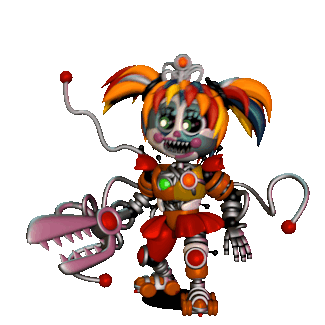


Pizzeria Simulator's iconic wretched dumpster clown!
Some of my finest modeling and animation! Scrap baby was a doozy of a design to try to simplify. She practically has the detail of every Sister Location character combined! Naturally, this proved to be quite the challenge, but in the end it turned out great. The shapes are very smooth and the rigging is exquisite. You can hardly even tell with how swift the animations are, but I was very deliberate with how those little wire-orb things were rigged. They move with the limbs and body to skillfully avoid obvious instances of clipping!
There were lots of hooks and curves involved in the blender process, and it was a meticulous and precarious process, but I managed to pull Scrap Baby together in about three days. After finishing her today, I figured "Hey, why not do a couple more! I have it in me!" And with that, my quest began. The next character(s?) I tackled was...
The Minireena duo!
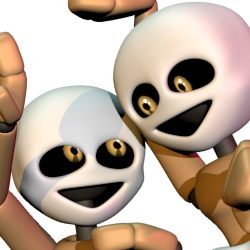
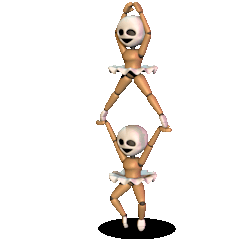
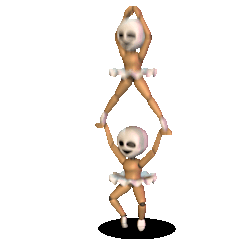

Everyone's favorite claustrophobic nightmare children!
I decided to go with two of them, in reference to Sister Location Custom Night's two different sets of Minireenas, and also because just one would be far too small!
Now these little punks were a delightfully obnoxious design process! I'd never had the (dis)pleasure of working with two separate armatures in one character before this, and it was quite the challenge. But you all know I like a good modeling/animation challenge. It gives the sometimes boring process some novelty!
Sidenote: Minireenas' eyes are kind of weird. They show up only in specific instances, but are absent the rest of the time. Obviously so, as you can see their little endoskeleton in their custom night icon. No eyes! I think Scott just needed a way to make their jumpscares a little more intense, and didn't want to worry about giving them eyes anywhere else. But hey, those beady yellow peepers definitely worked! They're quite the uncanny sight!
Next, we've got the one, the only...
Bonnet!
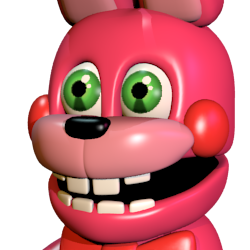
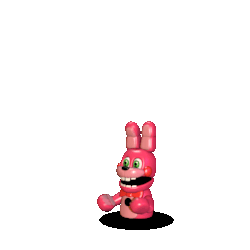


Sister Location Custom Night's very own adorable nuisance!
Remember earlier, when I mentioned how just one Minireena would be too small by itself? There wasn't any getting around it this time. Bonnet is, by all accounts, a palette swap of Bon Bon, but does that hold her back from having her very own identity independent of his? Absolutely not! Bonnet has set herself apart with her signature mosey, her insecurity about her (literal) button nose, and her unnerving ability to maneuver around without the aid of an uncanny, leg-bearing, scary bear companion! (Try saying that five times fast!)
It's a little tough to make a character like this work on their own, but I managed to pull it off, and have somehow produced some of my favorite animations so far. Her big leap is very rabbit-like, and it's pretty natural-looking. Her hurt animation has a little shiver to it, like she's shuddering from discomfort. Her animations managed to be very lifelike, despite the limitations of the character's design.
Next up, in a sort of redundant fashion, we've got...
Lolbit!

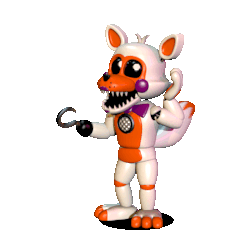

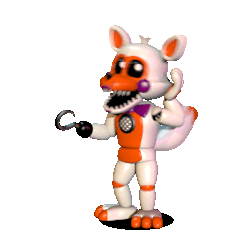
The oddball salesman adapted for the screen!
Kind of an odd choice of character, considering Lolbit's already been in FNaF World, but with their breakout roles in Sister Location Custom Night and Ultimate Custom Night since their initial debut, I figured it was prudent to include them. My working theory is that once the story of FNaF World had concluded, Lolbit got bored of hanging around in Animatronica, and decided to find some business elsewhere, winding up with their unforgettable inclusion as a face on a series of screens that forces you to type buttons on your keyboard. Not the most stunning appearance, but hey, it's unique! And it's funding the development of new and better Bytes! Then once their contract expired, Lolbit returned to Animatronica to continue developing Bytes, only to find that new shopkeepers had arrived to take their place. Naturally, this meant Lolbit had only one thing left to do: tag along with the adventurers to find someplace to sell without competition!
In contrast to Funtime Foxy's monstrousness, I gave Lolbit the cheeky, cheerful charisma they've been rocking in every one of their appearances across the franchise. As a result, Lolbit's animations are teeming with callous impudence!
Finally, the character you've all been waiting for, the main attraction, the star of the show... It's:
Gumball Swivelhands!

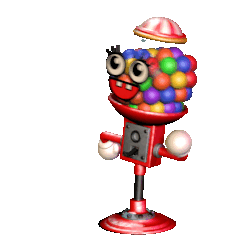
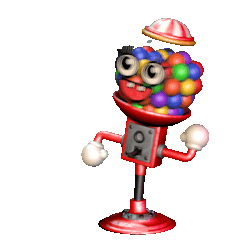
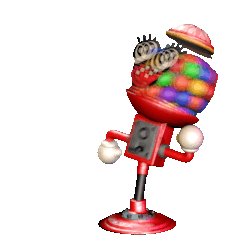
Pizzeria Simulator's shockingly stupendous sweet-supplier!
Bet you weren't expecting this one, were you? Move over Candy Cadet, Gumball Swivelhands is the new star of the candy-dispensing show!
This character was unexpectedly fun to animate, and I adored the opportunity to model its face, but I must say, that expression seems awfully familiar. I can't quite put my finger on it, but it makes me feel a profoundly frustrated sense of déjà vu...
Pizzeria Simulator is chock-full of memorable character designs, and despite its apparent genericity, there's always been something striking to me about Gumball Swivelhands. A concentrated sense of whimsy permeates this character like the suffocating aroma of six different flavors of bubble gum surrounds a gumball machine.
To me, this is what FNaF World is all about! Identifying and celebrating even the strangest corners of Five Nights at Freddy's history! There's a place for iconic, fan-favorite characters, right alongside obscure, sometimes even downright forgettable weirdos like this one! Five Nights at Freddy's is a freakshow, but not one that ridicules its freaks, one that holds them up high with a combination of joy and pride, like a father whose son has won the big sports game. "That's my son!" FNaF says, gesturing to the Eggbaby. "Hooray!" I scream from the bleachers. "Three cheers for these wonderful weirdos! Hip hip, hooray!"
I look forward to whatever I have to share next time. As always, thanks so much for tuning in! I'll catch you on the flipside!
#art#mellowtrashtrash#3d artwork#blender#3d animation#fanart#fnaf world#five nights at freddy's#fnaf#animation#circus baby#clown#gumball swivelhands#lolbit#scrap baby#fnaf sl#fnaf 6#bonnet#minireena
124 notes
·
View notes
Text
The Interweaving of Desmond & Eloise
an analysis on how they have been established as a pair

Collection of all essays so far
At the stage we are currently at, the end of chapter one with around thirteen hours of content to watch and even more outside of direct canon to examine, Desmond and Eloise have established themselves as a pair in a similar vein to Damon and Eva or Mark and Jett. Their pairing feels obviously deliberate and indicative of deeper meaning, which we’ll no doubt see more of as the game proceeds. In this essay I want to cohesively lay out all of my current thoughts on them - developed from TikTok posts I have made (x / x / x) with other newer points from my notes that do not appear in said posts.
While I personally enjoy their relationship in a romantic context, this is not intended as a ship post, and you are of course free to interpret it how you like. It’s just looking at how they relate to each other as characters and their canon relationship and giving my thoughts on what that means for them! Regardless of how you interpret the context of their relationship, that these two are being set up as close is undeniable.
SPOILERS FOR CHAPTER ONE AHEAD!
Firstly, I want to establish the significance of pairs in Project: Eden’s Garden overall. So much about the game circles back to pairs: the killing game ‘officially’ ending when only two remain, everyone waking up in pairs, Toshiko being the Ultimate Matchmaker, Tozu and Mara being a pair, bunking in pairs, splitting off into pairs… and much of this can be put down to the theming of the Garden of Eden with Adam and Eve. With everyone’s animal motifs, another Biblical story in Noah’s Ark comes to mind. The point is that the abundance of pairs is both relevant and very deliberate.
Fundamental design
From the moment we first see them in the train CG, Desmond and Eloise are together. When we first formally meet them, they are the only ones in the courtyard. They are a pair from the beginning in the same way as Mark and Jett and Wolfgang and Grace.
And, on first looks and first meetings, I’ll begin my thoughts on how they as individual characters relate to each other as foils with their visual designs and names. Being fictional characters, there was an entire design process filled with intent that went into creating them, and I really think Desmond and Eloise were created with the other in mind to make them both contrast and complement each other.
Their contrasting colour schemes of blue and black VS red and white immediately relate them to one another and put them in proximity of one another. Through their colour schemes they have been designed to be seen next to each other.
It is also their colour schemes that give instant insight into how they contrast each other in personality. Desmond’s blue suits his cool, composed disposition, his observant nature and how, although he is more reserved, he still integrates with the group and is a primary contributor. Throughout the situation and throughout all the suspicion he endures based on his talent, Desmond remains calm, in part, I think, because he knows he cannot afford to appear angry lest it confirm people’s biases. Considering how prominent that idea of prejudice has been with Desmond so far, I also heavily doubt him being designed as Black is coincidental or without connotations. Especially when you consider just how irrational the suspicion and assumptions placed upon him are.
(Desmond’s third Free Time Event, talking about how difficult a confined space like the academy is for him) Damon, internally: And yet, that cool demeanour of his never falters - even when talking about his situation. Is this what he means when he talks about discipline…?
Conversely, Eloise’s red speaks to her being more volatile - prone to outbursts of fear, panic and, notably, rage. It is interesting to me that Eloise’s colour scheme is primarily white/grey, with her reds as secondary and, in her clothing, beneath her uniform. But her eyes, the “windows to the soul”, are red. Eloise at first impression seems only timid, and this leads both characters and audience alike to assume that she is weak, and she is also reserved and rather closed off especially in conversation with the likes of Damon. But Eloise has a strong fortitude that manifests later in chapter one as she gains confidence in the setting - standing up to and threatening Grace, leading the accusations towards Grace in the trial, and her Free Time Events most notably. Her red is closed off until triggered. Damon notes that “the most confident she’s ever sounded” is when she’s expressing her belief that the runners of the killing game should receive the death penalty which so starkly contrasts with Desmond’s focus on resolving things peacefully. Similarly to Desmond being Black, I also heavily doubt that Eloise being designed as fat is without connotations regarding this theme.
The meanings of their names push this even more blatantly. Desmond’s name is of Anglo-Saxon origin and means “Great defender” which adds to how spelled out the theme of guarding, protection, defence becomes in his character during chapter one - notably in relation to himself and Eloise. In his blackmail, which I will go into in more detail later, it explicitly says he “guards the only one he trusts”. This defence finds contrast with offence in Eloise’s name being of French and Teutonic origin meaning “Fierce warrior” which speaks to how assertive she becomes when pushed. Her Free Time Events serve as good indication with how she says outright to Damon that she plans to fight back if targeted for murder and expresses anger when he starts “prying into [her] personal life” in an outburst of “It’s none of your f-fucking business!”. Down to their names they present as foils.
Linking to this talk on personalities and first impressions is how these two contrast in how they are perceived by other characters and audience alike - their shared theme of “judging a book by its cover”.
While Eloise has a talent centred around combat and wielding a blade, she is not nearly suspected the same way Desmond is due to her appearance as pale and soft in conjunction with her timidity, with the decision to make her fat adding to this as well. She is actually afforded first impressions based on personality, where Desmond is instead defined by potential threat in his marksmanship - the first thing Wolfgang ever says to him is, “With all of those weapons, I must ask…you…haven’t killed anyone, have you?”, and Eva’s belief that everyone is out to get her and have marked her as an easy target merges with preconceived notions about Desmond’s character and talent to lead her to assert that telling Desmond about his blackmail could “put [her] in danger”. Contrasingly, in building up to their confrontation of Grace, Damon perceives Eloise as “bumbling”, “uncoordinated”, and not of “any help in a verbal shutdown”, and he proceeds to be utterly proven wrong - with the use of “uncoordinated” in reference to the Ultimate Fencer giving great indication of his poor judge of character. This contrast, then, makes it notable how they stick together and understand each other in a way others do not.
(RE his bunking idea: Eloise understands what Desmond’s intentions are while others assume ill of him) Cassidy: I mean - hey, don’t expose us! That’s unfair! Desmond: Hold on, I’m not trying to expose anyone…! Eloise: Um, I think I get what he’s trying to say. Eloise: You just want everyone to be honest with each other…so we can cover all our bases…right? Desmond: Yeah…that’s right… (During the chapter one investigation as Grace guards Wolfgang’s room and denies everyone entry) Desmond: That’s what I tried telling everyone else, but they pretty much gave up. Jett and Mark went to the dining hall, Diana went to the laundry room, and Toshiko and Ingrid went to the courtyard. Desmond: Eloise and I, though…we’re not gonna let this slide.
When going through their Free Time Events, it becomes clear that Desmond and Eloise even contrast each other when it comes to their backgrounds and honing of their talents. Desmond comes from a notably wealthy family who have a history of Ultimate Marksmen - that talent being as hereditary as literal genetics. From the start, Desmond has been showered in opportunity - he mentions having an expansive field that puts the academy’s courtyard to shame, a personal shooting range, a personal tennis court, and a personal swimming pool. He used to attend competitions on a local and regional scale until he got the opportunity to compete in the Olympics.
Comparatively, Eloise had no such influence when it came to getting into fencing and simply joined a club and her honing of her talent was defined by a lack of opportunity. She rose through the ranks via forfeits - her opponents were so afraid they point-blank refused to fight her and so she had to take matters of improving into her own hands by practicing alone or with her teacher. Her lack of opportunity stems from how her family is certainly not as well-off as Desmond’s and she comments on giving her prize money to her mother and sisters. This is a point of similarity between the two - they both disregard the money they have earned through their talent for themselves and instead place focus on their families. Desmond cares more about making his parents proud, and Eloise cares more about giving the money to her family.
Beyond every aspect in how Desmond and Eloise foil each other is how similar thematically they are in a way that allows them to understand and trust one another in a way they don’t seem to lend to anyone else. They understand that the other is perceived by strangers in a way that doesn’t necessarily align with their fully realised selves, Desmond’s calmness soothes Eloise’s volatility, Eloise’s sword takes the front while Desmond’s guns and bows take the rear - they are an inversion of each other and interwoven as a pair.
To finish off with their fundamental designs, official art for Project: Eden’s Garden is, in my opinion, interesting to look at. Desmond and Eloise are depicted next to or interacting in some way with each other in every piece of official art they share which pushes them further as a ‘pair’. It really emphasises how rarely in-game they’re apart - with the only instances of that being during nighttime, every free-time after the first one, and most prominently the Prologue’s investigation. Otherwise, they are always at least in the proximity of each other. I don’t think official art and seeing which characters appear together the most and how exactly they are interacting is insignificant at all - two sets of Halloween official art stand out to me as entwining Desmond and Eloise by their talents. In one, Desmond is dressed as Link from the Legend of Zelda and wielding a blade and, in the other, Eloise is dressed as Artemis from Greek Mythology - the Goddess of the Hunt who was known for her archery, a choice that becomes especially interesting once you remember that Artemis’ fellow archer brother, Apollo, was heavily associated with swans.
Blackmail, blackmail

“With his weapons at hand, Desmond guards the only one he trusts.”
Since I posted my initial interpretations of this on TikTok, I’ve seen more discussion on it, and I don’t think it is controversial at all to suggest that the “only one” referred to here is Eloise. The only other options, to me, are this “only one” being someone outside of our main cast or Desmond himself. However, I have found myriad evidence that points towards it being Eloise that I’ve spread across different videos on TikTok but can now relay all in one place here.
First, what is meant by “weapons”? As the Ultimate Marksman, Desmond has access to guns and bows in the literal meaning of that and this is how Eva, Damon and everyone else interprets it. It is also true - Desmond is always depicted with his quiver slung over his back, so he does indeed have his weapons at hand. However, there is another way of looking at this - Desmond’s “weapons” do not have to be literal.
During chapter one’s trial, Grace admonishes everyone for “trusting Desmond so easily” after he defends himself from accusations based on the taser gun and Damon has the option of commenting on Desmond’s charisma that persuades people to trust him (or… “charm” as he puts it). Desmond’s “weapons” could refer to his rhetoric, especially with how he utilises the angle of ethos in comparison with Damon’s logos and Diana’s pathos - that being, focusing on getting across and defending his character, something that as previously discussed Desmond is exhaustively used to doing. His “guard” could manifest in him coming to this “only one”’s defence in verbal bouts just as much as it can be taken literally, something that we have in fact already seen if you subscribe to the idea of that person being Eloise.
Next, the meaning of “trusts” should be dug into. It is easy to assume that because Desmond behaves cordially with everyone and seems to possess a vested interest in getting everyone out of the killing game and to safety this means he is openly trusting in the way Diana is, but there is a lot once you start looking that proves otherwise. Desmond does not vehemently deny the possibility of murder like Wolfgang or Diana do but instead accepts the reality of their situation and approaches it with the knowledge of murder in his mind. He is against exploring the Alpha Sanctuary due to whatever Tozu has hidden within it, he takes note of the dangers of the pharmacy and what drugs could possibly be used to murder - even saying that “we should all start paying more attention to our food” - and is the one to come up with the bunk buddies idea due to the broken locks. Desmond does not trust that his peers absolutely will not be tempted by murder. Most illuminating is during his second Free Time Event when Damon tries to use the trustworthiness of the other students as a debate topic and Desmond becomes noticeably uneasy and closed off.
Damon: How about… we debate the trustworthiness of the other students? Desmond: Huh…? What do you mean? Damon: Isn’t it self-explanatory? You and I argue about whether or not the others are trustworthy. Desmond: Uh… I don’t know, dude. I’m not really comfortable with that. Damon: Why? Desmond: W-what do you mean why? I can’t just say my… (own emphasis) Desmond: I mean, I can’t just throw doubt at people for no reason.
Despite this, he still wants said peers to trust him. His motivation to escape the killing game and prevent murder, I believe, is genuine - however, he remains beneath the veil of hypocrisy in how he expects everyone to trust him without him trusting them.
So, how does this link to Eloise?
From the prologue, the theme of Eloise and Desmond being each other’s alibis and backing each other up is established. Wolfgang asks Desmond to keep a shaken Eloise company and he does so for the duration of all the other introductions. When the fake body of Cara is discovered, Eloise insists that she heard no screaming from the courtyard nor did anyone run out, and calls on Desmond to back her up, which he does. This is the first exchange of trust and reliance between them, and it only strengthens during chapter one.
The first major instance is in relation to Desmond’s idea of sleeping in pairs. Knowing his distrust towards his peers and that he has this one person he has an interest in protecting, it is notable both that he would be the one to raise concerns about the broken locks and that he would proceed to input that, “As the one who suggested the idea, I’d say we just pick our buddies ourselves-”. Desmond wanted to choose his bunk buddy, ostensibly so he would be able to more readily “guard” them, and this, I think, is crucial as evidence that the “only one he trusts” is someone among the class. While he doesn’t respond outwardly negatively to Toshiko’s desire to be in charge of the pairs and Ingrid’s subsequent assertion that they split by gender, this is easily explained by how intent he is on maintaining a calm disposition.
Eloise’s behaviour in this scene is equally noteworthy. She defends Desmond from accusations that he’s making people vulnerable and that she harkens to ideas of honesty and understanding Desmond’s intentions speaks to a building closeness between them. Much like Desmond, Eloise appears selective with her trust through how focus is repeatedly placed on her as ways to assign bunk-buddies is discussed, combined with how her character profile notes how she is “always ready to make her escape if anyone gets too close to her”, which I believe can be applied in both a literal-in-regards-to-fencing and figurative sense. We can discern from her Free Time Events that Eloise holds her privacy close to her and that she has certain people that she openly does not trust nor like - she doesn’t want to have a decision like who is going to be with her at her most vulnerable just chosen for her.
Toshiko: Fear not! In all my infinite wisdom and kindness, I shall pair the rest of you! Eloise: Ah… that’s not really necessary… (...) Ingrid: Strangers’ll usually be more comfortable spending the night with the same gender. Eloise: Then… we’re splitting it by gender…? (...) Wolfgang: We won’t have Ms. Kayura’s help, but I’m sure we’ll figure something out. Let’s go. Eloise: …
Furthermore, it does not feel at all coincidental that the scene directly after Desmond’s blackmail is revealed by Eva sees Grace pressuring Eloise to hand over her blackmail and Desmond attempting to defend Eloise before she reassures him. Eloise’s silence after Grace says that she better not have shown anyone speaks volumes - from the map during Free Time and their alibis for the time of Wolfgang’s murder alike we can explicitly see the amount of time these two have been spending around each other in the courtyard.
Grace: That fencer girl has been giving me the side-eye ever since the blackmail was announced. There’s no other explanation! Grace: Give it! Desmond: H-hey, stop that! Eloise: It’s okay…I’ve got it…
On the morning of Wolfgang’s murder, Desmond and Eloise spent all their time together in that courtyard, paralleling their positioning in the prologue. Just as then, they are each other’s alibis and they are the main one backing the other up. They proceed to stay by the other’s side literally throughout the investigation and figuratively throughout the trial. It is notable that textually Grace and Kai underscore how defensive Eloise and Desmond have been of each other throughout chapter one’s investigation and trial to accuse them of working together - ostensibly, Desmond being the murderer and Eloise his accomplice. When the two of them and Damon confront Grace during the investigation, they are largely backing each other up and adding to each other’s points while Damon chips in on his own - even going as far as to threaten Grace, knowing that she was shot at by Mara before.
Eloise: Um…for us to believe that, we need to see it ourselves… Grace: You think I’m lying? Desmond: There’s a chance you could be, unfortunately. (...) Eloise: Also, um…couldn’t this be considered breaking the rules…? Eloise: Tozu wants this game to be fair, but… being prevented from searching every room doesn’t seem very fair… Grace: …Even if it isn’t, what are you gonna do? Eloise: … Eloise: I’ll…report it to Tozu. Grace: A-ah? Desmond: Nice idea. What do you say we look for him now? Desmond: If Tozu agrees this is sabotage, he might call Mara to help…
In the trial, when Eloise first accuses Grace, Desmond backs her. When Grace’s innocence is proven and Eloise apologises for accusing her, Desmond continues to press Grace when she shouts at Eloise by insisting she “must know something about [Wolfgang’s] last known whereabouts”. When Desmond brings up the golf clothes and equipment in Wolfgang’s room, Eloise backs him. When Mark accuses Desmond of having access to weapons like the taser gun, Eloise reacts before Desmond does. During the nonstop debate about the taser gun, Eloise brings up her and Desmond’s shared alibi as they were together the whole morning. If the player takes the Pathos Route during the trial, it is Eloise’s voicing of her doubts in voting Diana and wanting to hear her side of the story that then leads into Desmond’s own agreement to hear her out. This series of events, I think, proves a degree of trust that has built between the two that they have not extended to anyone else - even during Eva’s execution and Diana’s speech, the two are depicted together.
The nature of Desmond’s blackmail combined with how he and Eloise are written in this chapter as consistent supporters of each other and consistently shown together leads me to be rather firm in my belief at the moment that Eloise is this “only one” his blackmail refers to. Their relationship is given as much focus as Damon and Kai and Wolfgang and Grace, which indicates the importance of it and really, really doesn’t bode well for their survival. My personal speculation at this current moment sees Eloise killing in self-defence, in which instance we will see Desmond’s ‘guard’ come to fruition.
Sharks and swans
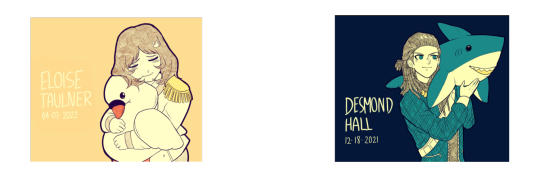
It can’t be a P:EG analysis without looking at the characters’ animal motifs - especially with how chapter one confirmed their relevance with the focus on Wolfgang, Eva and Diana in particular!
Desmond’s animal motif is a shark as represented by his shark’s tooth earring and this is immediately notable in tying into the dominating theme of prejudice and “judging a book by its cover” that has presented itself in contrasting ways in his and Eloise’s characters. Desmond being instinctively assumed to be dangerous and a ‘threat’ due to his position as the Ultimate Marksman directly correlates to how sharks are perceived in the media and, by extension, society. One way his shark motif is relevant lies in how it conveys this theme of being misunderstood.
As previously noted, the first thing Wolfgang ever says to Desmond is an interrogative question about whether or not he has killed someone before, it does not take any amount of mental gymnastics for Eva and Damon to agree Desmond’s blackmail makes him dangerous, and it does not take much convincing for the majority during the trial to agree on his likelihood of murdering Wolfgang due to the taser gun originating from his room. Surely, we are instantly reminded of how sharks are similarly misunderstood as obvious killers due to how they have been negatively sensationalised by the media - leading to a general consensus in society to view them as an inherent threat.
“Sharks have been vilified in human culture for centuries, and negative attitudes toward sharks continue to pervade mass media, perpetuating stereotypes, often conveying inaccurate information [7–11]. One way the public’s fear of sharks, which resonates deeply and viscerally, manifests itself is a pervasive overestimation of the likelihood of being ‘attacked’” (Andrew Nosal et al, 2016, The Effect of Background Music in Shark Documentaries on Viewers' Perceptions of Sharks, p.2)
Eva asserts that Desmond finding out about her having his blackmail could make her a target and, generally, the other characters are quick to assume ill intention from him. For example, him bringing up how everyone’s locks to their dorms are broken raises accusations of him exposing people and him testing people’s locks sparks similar reaction - with Wolfgang even denying him future agency by saying Desmond should go to him first.
Desmond’s shark motif combines with how his talent is perceived to beg us as viewers to deconstruct assumptions of him being this ticking time bomb waiting to explode - to pick apart preconceived notions, examine what makes you think that way and why. It is simultaneously fascinating and frustrating to see predictions from fans about how the rest of the game will play out position Desmond as an ‘obvious’ killer due to his marksmanship and because his animal motif is an apex predator painted as a “man-eating monster” by the media, ignoring how his talent has been handled thus far and contributing to the dominating narrative about sharks that does not reflect reality.
The majority of shark attacks on humans are results of curiosity bites on the shark’s end or mistaking humans for, say, seals. In personifying sharks and acting as if they have the same moral decision making as humans and go out of their way to maim and kill, they have become severely endangered themselves. In an article on shark conservation that analysed how sharks are portrayed in American and Australian media, it was identified that there were “four types of risks from sharks and fourteen types of risks to sharks in the articles” and that “Forty-four percent of the articles mentioned elevated public risk perceptions or fear of sharks” (Bret Muter et al, 2012, Australian and U.S. News Media Portrayal of Sharks and Their Conservation, Conservation Biology, Vol.27, No.1, p.190), which is to say that humans are more of a risk to sharks on the whole than sharks are to humans such as through overfishing, finning and habitat destruction and that this can directly parallel the ‘attacks’ on his character that Desmond has endured so far in the story.
In direct contrast in this respect, there is Eloise and her swan motif represented by her hairpin. The dominating cultural perspective on swans is that they are uniquely beautiful and elegant, they are symbols of purity and aristocracy and are a protected species in many countries including the US, UK and across the whole of the European Union. This places them at the utter opposite end of a general consensus scale to sharks and their features in popular culture reflects this from Hans Christian Andersen’s Ugly Duckling fairy tale to Tchaikovsky’s Swan Lake ballet.
Swan Lake is of particular note to me due to its duality of the white and black swan that can be applied to Eloise’s characterisation. Through her white clothing, fencer-defined elegance, and timid demeanour, Eloise brings to mind Odette the white swan - or the Swan Princess - who was cursed to be a swan by day and woman by night and who is revered for her beauty and purity. Contrastingly we have Odile, who impersonates Odette while she is bound to her swan form and is the ‘black swan’ - more conniving and wicked. Traditionally, Odette and Odile are roles performed by the same ballerina and so represent this idea of duality even more. Now, Eloise is neither conniving nor wicked, but she certainly is not the ‘Odette’ that people perceive her as on a surface level, and has assertive and, really, quite aggressive talons that unsheathe when she deems necessary.
(Eloise’s first Free Time Event, unprovoked) Eloise: If…if you ever try to do something to me… Eloise: …then…I’m going to fight back. (...) Eloise: Once, I completely overpowered a person using just a pen… Eloise: And, uh…if you don’t believe me… Eloise: …I…can give you a taste of what that person felt.
Additionally tied to this is the Medieval moralist view on swans as symbolic of hypocrisy. The idea stems from Hugh of Fouilloy’s Aviarium where he asserts that swans’ white plumage concealing their supposedly black flesh is reflective of a sinner who conceals their sins with a faux pious front…this line of thinking of “white = morality, black = immorality” is notoriously flawed and susceptible to challenge, and this specific idea alluding to black flesh even more obviously so. However, as a spiritual Christian belief, it is relevant when considering Project: Eden’s Garden not least because the game’s religious allusions ask us to question the very concept of Eden and how Western institutions use religious imagery - especially in how they distort it and use it for their own narrative. Every image of nature in the academy being artificial highlights this. Thus, this old idea about swans and hypocrisy may be taken into account… it is not so much direct hypocrisy that relates to Eloise, but the theme of appearance not reflecting reality and a warning to “not to be deceived by outward appearances” (Natalie Jayne Goodison, Introducing the Medieval Swan, p.12). Eloise’s character profile outright tells us to “not be deceived” (by her “size”, but this can apply generally).
And this neatly leads into the fact that swans themselves, despite their innocent and pure iconography, are fierce - especially when it comes to defending themselves or their nests. As Aristotle puts it in his (outdated by over two millennia yet still incredibly interesting) work The History of Animals, “[swans] will repel the attack and get the better of their assailant, but they are never the first to attack” (Trans. D’Arcy Wentworth Thompson, 9.12) and Eloise explicitly references this in her fight against her own underestimation and to combat the perception of her as weak both in form and fortitude. Despite what Damon believes, I refute the idea that Eloise’s volatility makes her emotionally weak because chapter one’s trial proves otherwise as does chapter one’s investigation that instantly sees Eloise disprove Damon’s idea of her. Speaking of Damon, it is interesting how he comes to respect and almost understand Desmond who is misunderstood as a threat by others much like himself, but cannot extend the same to Eloise whom he has no axis of relatability to.
“Still, it is significant that the administrative and agricultural experts voiced concern that aesthetic, cultural, and sentimental ideas about swans guide the birds’ protection in a strange or illogical way, and the resources expert agreed that the main—if not the only—value associated with continued protection of the whooper is sentimental value.” (Shauna Laurel Jones, 2018, Feathered majesty in the grainfield? Conflict, conservation, and the whooper swan in Iceland, p.39)
Desmond’s shark motif presenting through a shark tooth earring is not merely an aesthetic choice and instead possesses symbolic connotations. It is the choice in his design of a shark tooth earring that allows us to connect indigenous beliefs about sharks to his characterisation, as in indigenous Hawai’ian culture, shark teeth are traditionally worn as protective talismans, and certain species of sharks in indigenous Hawai’ian culture also relate to the concept of ‘aumakua’ where under certain conditions a deceased person is reincarnated as a shark and acts as a “beneficent guardian spirit” (Leighton R. Taylor, 1993, Sharks of Hawai’i: their biology and cultural significance, p.19) towards their family, both of which link to the increasingly potent theme of “guard[ing]” in Desmond’s character.
Similarly, we find ideas of “guard[ing]” with the swan, especially the idea of being guarded. Most blatant is the fact that swans are a protected species in many particularly Western countries such as the United Kingdom, the United States, France, Denmark, Germany, and Iceland, meaning it is illegal to kill or injure them. In a literary sense, we have the Finnish national epic Kalevala wherein the hero Lemminkäinen is tasked with killing a swan that swims and sings in the Lake of Tuonela that surrounds the underworld, but instead he is killed - not textually because he has attempted to kill a swan, but the context of swans as a protected species and how they are symbolically viewed certainly influences this narrative.
However, as a point of contrast, while sharks can be associated with life in the sense of survival and their integral position in ecosystems, keeping them intact, swans are associated overwhelmingly with death. Firstly examining the former, it is notable to me that Desmond’s animal motif is one heavily concerned with conservation efforts to protect against endangerment and extinction, conditions that are in no small part due to human impact. When one sees apex predator their mind tends to swipe to violence, to these creatures being bloodthirsty, instead of taking it for what it really is: an animal that plays an indispensable role in regulating ecosystems. Already, Desmond has cemented himself as a secondary contributor in trials alongside the likes of Jean, Ulysses and Wenona, and within the group he assumes a position not the extent of leadership like Wolfgang and Jean but certainly as a prominent initiator. Sharks have lived for millions of years and their survival is integral to the smooth management of marine ecosystems, to remove them would cause a disastrous knock-on effect. In tandem, the condition of its ecosystem is integral to the survival of the shark, which raises the aspect of Desmond’s Free Time Events that has him lament the lack of open space in the academy.
“As apex predators, sharks play an indispensable role in regulating marine populations, maintaining biodiversity, and preserving the health of our oceans (amongst many other parts they play in the tapestry of life that is below the waves). However, despite having roamed our oceans for millions of years, they currently face a myriad threats that of our own doing, including overfishing, habitat degradation, and climate change.” (Melissa Cristina Marquez, 2024, Exploring the Intersection of Indigenous Knowledge and Shark Science)
Turning to the association between swans and death is the ever-omnipresent swan song. The myth that swans are silent their whole lives until just before they die, when they sing their haunting song. Eloise can be interpreted according to this in how “silence” can be applied to her initially reserved and shy nature, with the more she develops across the story akin to the theme of transformation found in many European folktales and, unfortunately as a result, becomes closer to death her development in becoming more openly confident will be her “song”.
My personal speculation at the moment is that Eloise will become the blackened through killing in self-defence - something I find fitting for her characterisation, predicted character arc, fencing talent, and swan motif all in one - and so her swan’s song will manifest as her final plight during her trial before she is inevitably sent to death. Relatedly, the conclusion of Swan Lake sees Odette, the swan princess, and Siegried, the prince, die together. I view Desmond and Eloise’s relationship to end in one of two ways - either one of them kills/is killed and the other kills/is killed the chapter after, or one of them kills/is killed and the other survives. Either way, they cannot both live.
The silver Swan who living had no note, When death approached unlocked her silent throat; Leaning her breast against the reedy shore, Thus sang her first and last, and sung no more: "Farewell all joys! O death come close mine eyes, More geese than swans now live, more fools than wise." (Unknown author)
And so arrives the final point to wrap this whole essay up in one neat bow: Eloise’s swan motif presents in her unwavering loyalty as a pair with Desmond. This is so unsubtle that it is underscored by Grace and Kai in the chapter one trial, sending accusations of them working together to murder their way. As has been reiterated, the two are seldom not depicted together, react to accusations towards each other with the same intensity were they to be directed at them, and defend each other with a consistency they do not afford any other character, with only Diana coming close in Eloise’s case. Like swans who mate for life, Eloise and Desmond have essentially become pair bonded. This happening so quickly is not necessarily a cause for doubt either in my opinion as that also connects to swans who bond as a pair even before they reach sexual maturity at twenty months despite living for a good two decades, and we know Eloise and Desmond’s time is far shorter than that.
“Someone has to leave first. This is a very old story. There is no other version of this story.” (Richard Siken, War of the Foxes)
With everything we have of them so far, regardless of how Desmond and Eloise’s individual stories play out, they will be in one way or another entwined.
Thank you for reading, and I would love to know your thoughts!

BIBLIOGRAPHY:
Aristotle, Thompson D. W.,The History of Animals
Goodison N. J., 2023, Introducing the Medieval Swan
Hugh, 1172, Aviarium
Jones S. L., 2018, Feathered majesty in the grainfield? Conflict, conservation, and the whooper swan in Iceland
Lönnrot E., 1835, The Kalewala
Marquez M. C., 2024, Exploring the Intersection of Indigenous Knowledge and Shark Science
Muter B. et al., 2012, Conservation Biology, Australian and U.S. News Media Portrayal of Sharks and Their Conservation, Vol. 27, No. 1
Nosal A. et al., 2016, The Effect of Background Music in Shark Documentaries on Viewers' Perceptions of Sharks
Taylor L. R., 1993, Sharks of Hawai’i: their biology and cultural significance
Tchaikovsky P. I., The Swan Lake Ballet
101 notes
·
View notes
Text
Dorothy's Top Five Games of 2024
Honorable Mentions:
Suzerain: A gripping and fully-developed world of politics and international relations, Suzerain released its Rizia DLC this year, and I played through both it and the main campaign. Its realistic portrayal of political and economic processes, in the backdrop of a world almost our own, proved extremely addictive.
Goodbye Volcano High: A heartfelt and moving interactive animated miniseries about coming of age in apocalyptic times, with some great indie rock-flavored music.
We Love Katamari Reroll: A delightful followup to the original Katamari Damacy, We Love Katamari is more of the same - and what more could you ask?
Sea of Stars: A beautiful love letter to classic JRPGs, with gorgeous environments, delightful timing-based combat, endearing characters, and wonderful music, including guest tracks composed by legend Yasunori Mitsuda.
Dragon Age: the Veilguard: Now the story of a studio who lost everything, and the one game that had no choice but to get them back on track. It’s Arrested Development.
And now, the list proper.
Fifth Place: Penny's Big Breakaway (Evening Star)

I have a tremendous soft spot for 3D platformers. Some of my earliest memories of video games involve playing Super Mario Sunshine, Sonic Adventure 2, and Spyro (the bad one) on GameCube.
Penny's Big Breakaway feels like a refugee from that era of platformer, one which would have felt at home on the Dreamcast, GameCube, or even the original Xbox or PlayStation 2. It combines energetic, almost frantic platforming with a high skill ceiling and combo system with a turn-of-the-century graphical aesthetic and fantastic music by Tee Lopes to provide a return to form for a genre which has for too long been permitted to languish.
As with most 3D platformers, story is not a major focus. You play as Penny, a yo-yo-toting busker who ends up running afoul of an emperor and must escape imprisonment by his army of colorful penguins. That's it. That's all you need. This simple premise provides ample excuse for Penny to run, jump, and roll her way through a host of themed worlds. Sometimes, less is more.
With that said, this is not a perfect game. The controls take a lot of time and effort to master, and even after a good amount of play time one is liable to fling oneself off of the map. Health powerups are not as plentiful as they should be, especially in boss encounters, and a lack of camera control can be downright painful at times. Still, these complaints do not ruin the game, and hopefully they can be addressed in a sequel.
The developers of Sonic Mania have created a true gem with this, the debut game from new studio Evening Star, and I look forward to seeing what the studio comes out next - like the best platformer mascots, Penny has the charisma and style to inspire adventures for years to come.
Fourth Place: Neva (Nomada Studio)
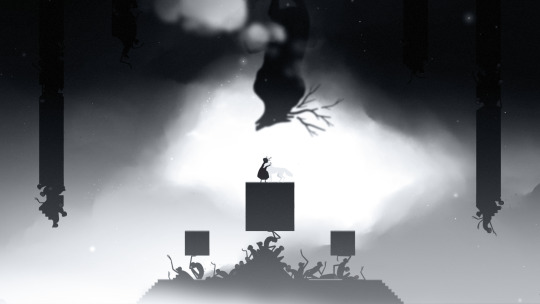
Neva is the latest release from Nomada Studio, creators of the brilliant game Gris, and where Gris was a parable of grief and loss, Neva is an ecological fable in which a girl and her dog must make their way through an increasingly-ravaged natural world beset by decay and corruption.
The core gameplay of Neva builds and iterates upon what was seen in Gris, with a dash, double jump, and ground pound, but added in are a sword, which main character Alba uses to fight enemies as well as unlock obstacles, and abilities involving the titular dog which are unlocked over the course of the game. The combat is fun but fairly rudimentary, and I saw it as a garnish on the real focus of the game, which is robust and engaging puzzle platforming of the kind that made Gris such a delight.
The game, as expected of Nomada Studio, is gorgeous, with a beautiful art style, impeccable sound design, brilliant use of color, and haunting, atmospheric music. The level design is also excellent, spanning a number of natural environments which are slowly but surely overtaken by the creeping decay, as well as man-made structures resembling those in Gris, which are also crumbling and in a state of decay. The degradation of nature and collapse of the structures of man are linked in Neva, giving rise to uncomfortable thoughts about the state of the world today.
Neva is defined by cycles, cycles of life, death, decomposition, and the cycle of the seasons, which give each of the game's four chapters their names. The game ends in an echo of its beginning, a beautiful and bittersweet ending I will not spoil here.
Neva is a hauntingly beautiful, if frustratingly short, gaming experience which I think will stay with me for a long time. I felt compelled to hug my dog after it was done.
Third Place: Metaphor: ReFantazio (Studio Zero)

When Metaphor was first announced, the impression that everyone got was that it was fantasy Persona, with a large amount of development staff carried over from the Hashino Persona games, a lot of mechanics and systems carried over from those games, and even some summonable demons from the mainline Persona and Shin Megami Tensei games. Commentators made note that this was fantasy Persona. Journalists endlessly referred to it as fantasy Persona. Reviewers regarded it as fantasy Persona. It was such a cliche, so aggravating to fans, that it became verboten in the fanbase to refer to the game as fantasy Persona.
Metaphor: ReFantazio is fantasy Persona. This is in no way a bad thing. As in the Hashino Persona games, there is an emphasis on social simulation, with the main character forging bonds with his party members and honing his social skills - not to self-actualize as a social being, as in Persona, but to prove his mettle and worthiness as a king to a kingdom cast into chaos after the last king's murder.
It is this emphasis on fantasy that sets Metaphor apart. The game is constantly musing on fantasy tropes and the transformative nature of the genre, and it has a surprising amount to say about the appeal of fantasy narratives, to say nothing of its overarching themes of prejudice and self-determination.
In terms of gameplay, Metaphor actually takes a lot more from the Press Turn system of Shin Megami Tensei than the One More system of Persona, and it took me a while to get into the groove of it. Once I did, though, I had a great time chaining attacks to strike at opponents' weaknesses and finishing my turns with devastating damage via the game's Synthesis mechanic. The game's central gameplay feature, the Archetype system - a sort of job system like those in Sqaure Enix RPGs - was also something I took to readily after some initial fiddling. The game lets you mix and match abilities from different archetypes via the skill inheritance system, and I had a lot of fun creating an ideal build for each playable character.
And then, of course, there's the characters. Metaphor features a large cast of characters, and I was happy to see that all of the social link equivalents featured strong and compelling narratives that made the time needed to invest in each rank of their story a worthy commitment. In particular, I found the narratives of Eupha, Heismay, and Maria especially compelling, and the bonuses provided through spending time with them to be particularly valuable.
Metaphor: ReFantazio is fantasy Persona. And that's a good thing! It's a great game, and I hope it's one that gets revisited sooner rather than later. Studio Zero have produced a real gem for their debut title, and I really hope they keep the momentum going.
Second Place: Ghost of Tsushima: Director's Cut (Sucker Punch Productions)

I am a huge fan of the works of director Akira Kurosawa - Throne of Blood is my favorite film of all time - and the jidaigeki genre of samurai films in general, so when I learned that Sucker Punch was making a game inspired by the genre I was filled with excitement which turned to dismay when I learned that the game would be PlayStation exclusive. Thankfully, though, little stays PlayStation exclusive for long, and I was happy to finally play Ghost of Tsushima when its Director's Cut released on PC this year.
The setup of Ghost of Tsushima is pretty simple, and slots in nicely with its genre - you play as Jin Sakai, the sole survivor of a massacre of samurai at the hands of invading Mongols, and must use all the tools at your disposal to free the jito, your uncle, and liberate your island home of Tsushima. Along the way, you begin to chafe at the code of honor you are expected to uphold as a samurai and as your uncle's heir apparent. While Ghost does have a simple premise, it is its characters, and their struggles and dreams, which kept me invested throughout the experience.
The game's combat is consistently satisfying, with the player rotating through various swordfighting stances to counter specific enemy types, while also having access to a bow, bombs, poison darts, and various quickfire items which can disrupt enemies and allow you to control the flow of combat. It's a fun system to master and learn how to get through any encounter without taking any damage. Occasionally the game also puts you in one on one duels with certain enemies, which are always fantastic - the one at the end of the game especially.
Where Ghost really shines, though, is in its exploration. I wouldn't call Ghost of Tsushima a true open world game - the player's access to the island's various regions is gated by story progression, and you unlock more of Tsushima as you progress, while having free reign of any area you have access to at any given time. The game heavily rewards exploration with a variety of activities and collectibles, which differentiate themselves from the typical Ubisoft-style open world icons by being fun, useful, and engaging. You'll scale mountains to reach a shrine to a kami, or rest for a while in a hot spring to increase your health, or (anachronistically as the art form did not exist in the 13th century) compose a haiku to earn a new piece of cosmetic gear. You'll also follow a number of character-based side stories, one-off side quests, and mythic tales which unlock powerful abilities and armor, all of which are extremely engaging and memorable. I would liken Ghost of Tsushima to last year's Tears of the Kingdom in terms of just how good it feels to explore and discover the island of Tsushima's beautiful environments, and uncover all of its secrets.
As a lover of the genre, I could barely put Ghost of Tsushima down in my initial playthrough of over 70 hours. It more than earns its spot on the list, but there's just one game I think left even more of a mark on me this year.
First Place: Persona 3 Reload (P-Studio)

I am a recent convert to the Persona series, having first played Persona 5 Royal in 2022 and playing Persona 4 Golden when it released on Xbox in 2023. However, I have fallen deeply in love with the series, and when Persona 3 Reload was announced I made the decision that I had to play it on release day. I called out of work and preordered the game - something I never do - and through a combination of being trapped in my home by a massive storm and losing my job the next week, I ended up plowing through Persona 3 Reload in about a week. I simply couldn't put the game down.
I had very little knowledge of the story or characters of Persona 3, having never played my copy of Persona 3 Portable since this game was announced so soon after that released, and so experiencing this narrative for the first time was an experience I'll never forget. Persona 3 is a game about death which is simultaneously extremely life-affirming, celebrating the relationships, connections, and simple joys that make life worth living, while embracing the fact that everyone must someday die and using that fact as motivation to live every day to the fullest. It is a moving, emotional story anchored by rich, engaging characters. I cried several times throughout.
The gameplay of Persona 3 Reload, a refinement on the turn-based systems of previous entries, is polished to a shine, and I found myself blowing through whole blocks of Tartarus, the game's only dungeon, in a single in-game night due to how engaging and addictive the combat felt. It felt extremely rewarding to find effective combos and a synergistic team that could raise each character's Theurgy gauge as quickly as possible, and the structure of Tartarus hooked me in surprisingly effectively, given that I wasn't a big fan of Persona 4's TV Wortld dungeons, or Persona 5's Mementos, dungeons with a similar structure to Tartarus. It helps that there's a surprising amount to do in Tartarus, from rescuing lost civilians to fulfilling requests for the Velvet Room attendant Elizabeth to exploring the various Monad Doors and plundering their rare items.
Persona 3 Reload is a very special game, one that I think will stick with me for a very long time. I can easily see why fans had been clamoring for a remake for so long, and I am extremely grateful that we finally got this game as a result. It is a genuine masterpiece, and easily takes the title of my game of the year.
101 notes
·
View notes
Note
Hello! 😊 Do you have any advice on word-building? I can imagine multiple scenarios in my head, but I can't seem to put them into words. 🥹
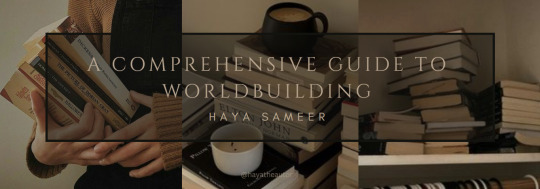
First off hi sorry I took forever to write this blog! I hope it helps you get your ideas onto paper <3
Worldbuilding is the backbone of any compelling story, especially in genres like fantasy, science fiction, and historical fiction. Crafting a believable, immersive world can captivate your readers and provide a solid foundation for your narrative. In this guide, I’ll walk you through the essential steps to create a vivid and engaging world for your story.
Understanding Worldbuilding
Worldbuilding involves creating a complete, fictional universe that serves as the setting for your story. This process includes developing geography, cultures, history, politics, and even the rules of nature and magic (if applicable). The goal is to make your world feel as real and intricate as the characters who inhabit it.
Starting with the Basics
Define the Genre and Tone
Consider the genre of your story. A high-fantasy world will have different requirements than a dystopian future or a historical setting. The tone—whether it's dark and gritty or light and whimsical—will also influence your worldbuilding decisions.
Establish the Setting
Start with the physical world. Sketch out maps, outline the geography, and decide on key locations where your story will unfold. Think about the climate, natural resources, and the flora and fauna that inhabit this world.
Develop a History
Create a backstory for your world. Major events, wars, discoveries, and cultural shifts shape the present-day setting. A rich history can add depth and realism, influencing characters’ beliefs and motivations.
Building Cultures and Societies
Craft Unique Cultures
Think about the various cultures in your world. What are their customs, traditions, and social norms? How do they dress, what languages do they speak, and what religions do they follow? Diverse and well-thought-out cultures can add layers to your narrative.
Political Systems and Power Structures
Define the political landscape. Who holds power, and how is it distributed? Are there monarchies, democracies, or tribal councils? Consider the relationships between different nations or groups and the potential for conflict.
Economics and Resources
Understand the economy of your world. What resources are abundant or scarce? How do people trade, and what currencies do they use? The distribution of resources can drive plot points and character motivations.
Crafting Magic and Technology
Magic Systems
If your world includes magic, establish clear rules and limitations. What are the sources of magic? Who can use it, and how? Consistent magic systems prevent plot holes and maintain suspension of disbelief.
Technology Levels
Consider the technological advancements in your world. Are they using medieval weapons, steampunk machinery, or advanced futuristic gadgets? The level of technology can influence daily life, warfare, and exploration.
Time and Place
Historical Context
Establish the timeline of your world. Is it set in the past, present, or future? Consider historical events that have shaped the current state of the world. How have these events influenced societal development and cultural evolution?
Daily Life and Schedules
Describe the daily routines of your characters. What does a typical day look like for different social classes or cultures? Consider work hours, leisure activities, and societal expectations. The pace of life can vary greatly depending on technological advancements and cultural norms.
Timekeeping and Calendars
Develop a system of timekeeping and calendars. Are there specific seasons, festivals, or holidays that are significant? How do people measure time—by the sun, moon, or a mechanical clock? Unique timekeeping methods can add depth and authenticity to your world.
Clothing and Fashion
Cultural Significance
Explore how clothing reflects cultural identity, status, and occupation. Different regions and social groups might have distinct styles, fabrics, and accessories. What materials are commonly used, and how are garments crafted?
Fashion Trends
Consider the evolution of fashion in your world. What are the current trends, and how do they vary across different societies? Fashion can be influenced by historical events, climate, and interactions with other cultures.
Practicality and Symbolism
Think about the practicality of clothing in your world’s environment. How does the climate affect what people wear? Additionally, consider any symbolic meanings attached to certain garments or accessories. For instance, specific colors or patterns might denote rank or allegiance.
Religion and Beliefs
Pantheon and Deities
Create a pantheon of gods or a single deity, depending on your world’s religious structure. What are their characteristics, domains, and myths? How do they interact with mortals, if at all?
Rituals and Practices
Detail the religious rituals and daily practices of your world’s inhabitants. Consider ceremonies, festivals, and rites of passage. How do these practices influence daily life and societal norms?
Religious Institutions
Define the structure and influence of religious institutions. Are there temples, churches, or shrines? What roles do priests, shamans, or other religious figures play in society? The power dynamics between religious and secular authorities can add layers to your worldbuilding.
Languages and Communication
Linguistic Diversity
Develop the languages spoken in your world. Are there multiple languages or dialects? Consider the history of these languages and how they evolved. Language can be a powerful tool to convey cultural diversity and conflict.
Writing Systems
Design writing systems and scripts used for communication. Are there ancient texts or runes with special significance? How do literacy rates vary among different social classes and regions?
Non-Verbal Communication
Explore other forms of communication, such as body language, sign language, or symbolic gestures. How do people convey messages in situations where spoken language is impractical? These non-verbal methods can add depth and realism to your interactions.
Integrating Worldbuilding into Your Story
Show, Don’t Tell
Instead of dumping information on your readers, reveal your world organically through the narrative. Use dialogue, actions, and descriptions to weave worldbuilding details seamlessly into the story.
Character Perspectives
Different characters will experience and interpret your world in unique ways. Use their perspectives to highlight various aspects of your world, making it richer and more complex.
Consistency and Continuity
Maintain consistency in your world’s rules and details. Keep track of your worldbuilding elements to avoid contradictions and ensure a cohesive narrative.
Worldbuilding Tools and Resources
Maps and Diagrams
Create visual aids like maps, family trees, and diagrams to help you keep track of your world’s layout and relationships. Tools like Inkarnate or Wonderdraft can be helpful for map-making.
Worldbuilding Bibles
Maintain a worldbuilding bible—a document where you compile all your world’s details. This can include notes on geography, history, cultures, and more. It’s a valuable reference as you write and develop your story.
Inspiration from Real World and Fiction
Draw inspiration from real-world cultures, histories, and landscapes. Similarly, reading widely in your genre can provide insights into effective worldbuilding techniques.
Final Thoughts
Worldbuilding is a rewarding yet challenging aspect of storytelling. It requires imagination, attention to detail, and a deep understanding of your narrative’s needs. By following this comprehensive guide, you can create a vibrant, believable world that will captivate your readers and enhance your storytelling.
Looking For More Writing Tips And Tricks?
Are you an author looking for writing tips and tricks to better your manuscript? Or do you want to learn about how to get a literary agent, get published and properly market your book? Consider checking out the rest of Haya’s book blog where I post writing and publishing tips for authors every Monday and Thursday! And don’t forget to head over to my TikTok and Instagram profiles @hayatheauthor to learn more about my WIP and writing journey!
#hayatheauthor#haya's book blog#haya blogs#writing community#writing tools#writer things#writing advice#writer community#writing techniques#writing prompt#writing stuff#creative writing#ya writing advice#writing tips and tricks#writer tools#writers of tumblr#writer blog#writers block#writers on tumblr#writerscommunity#writer stuff#author help#author advice#writing#author#quillology with haya#worldbuilding#world building ideas#fantasy worldbuilding
218 notes
·
View notes
Text
★’・゚:。・:*:First kiss with HSR characters PT.1:。・:*:・゚’★
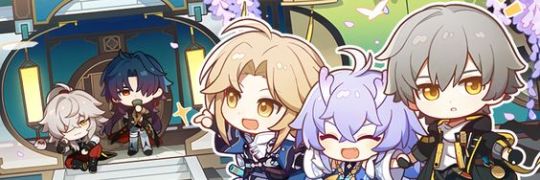
【Note: Hello! I haven't written anything in a while, but I recently got a surge of motivation, so why not take advantage of that? :) There will be a few parts because I want to write for many characters and the process of writing each one is really long for me so I prefer to spread them out a bit, so if the character you would like to read about isn't here, keep an eye out for future parts, perhaps I will include them there! As per usual, English isn't my first language and I'm learning as I go, please be patient with me. Requests are open! (˵ •̀ ᴗ - ˵ ) ✧】
【Pairings: Kafka, Argenti, Blade x GN!Reader】
【CW: I may have added some angst here and there, but I couldn't resist (I tried to end it with a good, slightly bittersweet conclusion each time though)! I wanted to make the characters' traits as similar to the game's as possible, but a few things may still be out of character, sorry in advance!】
a lil note: this is literally just all of these characters being absolutely SMITTEN for you and them fawning over you, but every day is a good day to get praised left and right, no?
☆〜KAFKA〜☆
It shouldn't be much of a surprise that you fell in love with this young and exceptionally charming woman. As a Stellaron Hunter, she ensures that Elio's predicted plans are carried out. That being said, you were a completely unpredicted element in a series of missions; there was never a mention of you ever being included in situations that you always found yourself stuck in. Kafka always saw it as "the usual result of the unforeseen nature of destiny," as she liked to explain to you.
After a while of simple acquaintance, she has grown more fond of you than she has of anyone. Not only were you beautiful in her eyes, which was a big thing for a connoisseur of beauty such as herself, but she felt at ease with you. She may be a sly, unbothered criminal whose prize for capturing her is enough to provide many good-lived lives for a bunch of Vidyadharas, but she actually really appreciates the times when she doesn't feel like she's being chased by people or by time itself.
Being with you was as enjoyable as studying the waves—a peaceful activity, a thought-provoking process. She desired to look at the horizon and discover more than meets the eye, however, it was quite impossible. The job of a Stellaron Hunter is challenging not only because of the relentless pursuit of destiny and the never-ending dangers but also because it entails never staying in one place for too long, never forming more meaningful connections, and never attaching yourself to finite, frail matters. Even though she knew she was more unlikely to run into the same individual twice as a Devil Hunter than she was now, her options were usually limited.
Kafka isn't one to fully hide her true feelings; she spoke very highly of you, your way of being and thinking, your appearance, and your tendency to be the miracle of one's destiny (*cough* talking about herself there). She has developed a habit of complimenting you just to see you squirm away from her gaze and bite your lower lip to try and stop a smile from forming. These occurrences weren't rare; they always followed the same pattern: she said something = you discreetly reacted = she noticed and couldn't stop noticing.
A kiss from her would be more of an indication of her love than a reveal, showing rather than declaring it. It may have happened during one of your late-night chats where you slowly opened up to one another, or it could have happened in the early morning after she invited herself into your home after you had just woken up and weren't sure if you were still asleep. In any case, without having said much, she leaned in, rested her hand on your cheek, and left a tender and delicate kiss on your lips. It didn't last long, but it meant more than a decade of stolen glances and conversations with hidden meanings.
It didn't feel like a goodbye kiss, it never did, but it was clear it was some form of leaving you wanting more, leaving you yearning for her to come back and see you again, and leaving you wondering how long it would be before she does it once more.
☆〜ARGETNTI〜☆
Knight of Beauty, a follower of the fallen Aeon Idrila. He's constantly on the journey to honor the principles of beauty itself, spreading the grace of his Goddess all over the universe. Discovering numerous forms of beauty in the ordinary and in the extraordinary. When he first laid his eyes on you, it was as if time began to bend around you, a black hole in which the concept of time didn't seem to exist, trapping anyone and everyone residing in its proximity.
Recognizing refinement in people was second nature to him, admiring their souls that mirrored their personalities and beliefs. He wished nothing more than to convey compassion to those who possessed honorable qualities, pure hearts, and desirable traits. Your beauty shone with such radiance that it put the stars to shame; your existence was an excellent reminder of Idrila's presence in the universe.
To Argenti, love is a miraculous feeling that is a joy to experience; it reflects a person's deepest desires and is an act of care so poetic that it almost brings a tear to the eye. In a way, having never experienced it before and having no opportunity to try due to his commitment to traversing in solitude, he decided it wasn't he who was supposed to feel it and that he was merely destined to admire the beauty of it from afar.
Meeting you meant the world to him; you made him feel love for another person for the first time—the all-consuming love from every classical novel he had read. The purest form of it is tragic love, one that breaks down the foundations that hold one's life in perfect balance. He spent several days and nights with you, staying in one location longer than he ever did since becoming a knight—the place where he started to ponder his destiny and his vocation.
He made every effort to push these thoughts away, thinking such things felt like a violation of the universal code of chivalry he upholds, yet when he gazed at your gentle smile as he held your hand, it was a tougher battle than that of a wax candle facing the sun. He was melting into a pitiful puddle as your very being formed him again, never to be the same as before.
One beautiful night, when the birds had gone to sleep, no expectations were laid forth, and no secrets were to be unveiled, Argenti took you by both hands, kissing each knuckle as if they would break if he put pressure on them. He spoke of you as if you were the one he had devoted his life to worshiping, his lips singing silent praises; perhaps it was a prayer, perhaps an apology. His eyes met yours, a nonverbal plea, and you leaned in, connecting your mouths in a passionate kiss, electricity coursing between each soft teeth clashing.
What an outstanding farewell kiss that was. The thought alone made you gulp down the lump growing in your throat. Argenti has to leave, or rather, ought to leave; otherwise, he's afraid he may decide to stay. He's certain your paths will cross one day; it's just the way of the world. Either way, he always finds himself drifting towards beauty. Behind him, he will leave a timeless tale of a wounded and repaired heart, as well as a dose of fate that makes no mistakes.
☆〜BLADE〜☆
The undying man who became a blade, a shell of a person, a mara-stricken monster with no hope for craved demise. His story is one of endless agony and misery. In this everlasting life, Blade's abilities are used in matters including bloodshed, spreading the pain he felt himself, and only then would he feel himself disappear, even for a moment. As bitter as that was, it was reality, his burden to bear. Blade didn't have "companionships" and never needed attachments. The closest he had to an acquaintance was Kafka, whose voice managed to calm the monsters who grew inside him relentlessly, and possibly Silver Wolf. However, he didn't understand her, nor did he wish to.
How you were able to capture his wounded heart remains a forever-unsolved mystery. He, of course, didn't decide one day that the way you laughed made him feel emotions so intense that he wondered if what he was feeling was some form of suffering he'd never experienced previously or that his intensified urge to protect you wasn't just due to the fact he was always nearby when danger struck, but because he genuinely cared. It was a lengthy process imbued with a myriad of understatements and denial. An "I love you" leaving his lips was as bizarre as the prospect of hell freezing over... yet when it did happen, you only wished to hear it again.
He frequently wonders why he finds himself faintly grinning primarily in your presence alone (and obviously during combat). When you resided in his vicinity, everyone could feel a shift in the atmosphere surrounding him, as well as a change in his usual behavior. It was almost comical to observe, especially to his fellow Stellaron Hunters, who never missed an opportunity to tease him. Nonetheless, love expressed by a presumably loveless man is as fascinating as it is arduous. Your existence was curative, helping him to rediscover parts of humanity he thought he had lost, yet healing is a part of him he has come to loathe with every fiber of his being. At one point, he distanced himself, as if limiting your healing influence on him was the sole thing that he could control about his 'condition'.
That didn't last long, and he scurried back to you like a moth to a flame. Blade didn't grasp the concept of physical touch as a kind of comfort; it never failed to remind him of how many times he had been hurt. You, once again, were the exception. Gentle arm touches, random lacing of fingers, your scent, and that insufferable (not really) look in your eyes whenever you stared at him drew him in. As much as he despised life, he did not detest the idea of living simply to be with you; that paradise that always seemed to be out of his reach, a mere push away, appeared to be standing right in front of him.
A minor brush of your body against his made you excited, but a kiss? It's overwhelming to even imagine. You'd have to initiate it, subtly steering the conversation to a topic where it wouldn't be too odd to inquire about moving to the next step in your relationship, acting as lovers. If Blade didn't wear a stoic expression on his face more than half the time, you could tell by his nervous swallowing that he would be at least blushing a little. He wasn't an adolescent, and he didn't think of a kiss as the grandest gesture of intimacy; nevertheless, that didn't free him of hesitations. Being vulnerable and helpless in the hands of another, all of his shortcomings could be easily revealed.
Kissing Blade had to come naturally when you were alone and indulging in small talk; there was no need for a perfectly timed gust of wind or a captivating blanket of stars above, just two imperfect people pouring all of their desires, yearning, and passion into a single imperfect kiss. Your lips met, linking your souls and creating a sensible spark deep within. There was no distance between you, and you were both entirely defenseless against the other's will. After you moved away, it was as if a thousand sentences were pulled from your mouths, yet no one spoke a word. With swollen lips, you were unable to resist a grin while Blade leaned in for another kiss.
lil ending note: hope you enjoyed! also, I have to mention that I know that both Kafka and Blade are Stellaron Hunters so the main problem portrayed in Kafka's part (the never being in one place too long) could potentially be brought up In Blade's part as well, but I decided that would be pretty repetitive so I wrote about Blade's history instead :D
#honkai star rail x reader#honkai star rail x gender neutral reader#honkai star rail x male reader#honkai star rail x female reader#kafka x reader#kafka x you#kafka x y/n#argenti x reader#argenti x you#blade x male reader#blade x reader#blade x you#blade x y/n#blade x gender neutral reader#blade x female reader#hsr x reader#hsr x you#hsr x y/n#hsr x gender neutral reader#hsr x male reader#hsr x female reader#argenti x male reader#argenti x female reader#argenti x gender neutral reader#kafka x female reader#kafka x male reader#kafka x gender neutral reader
459 notes
·
View notes